
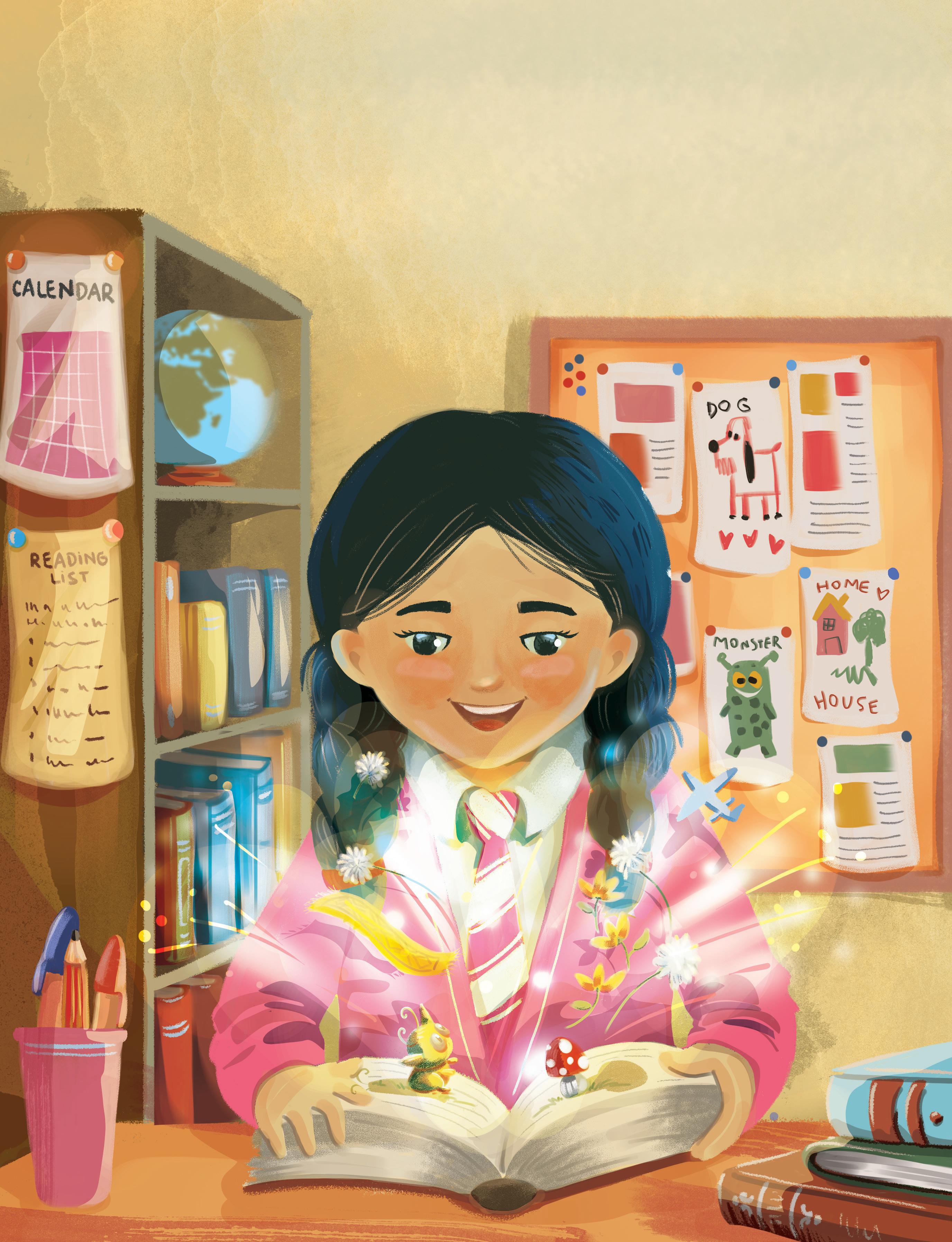



Get access to animated learning videos, interactive quizzes, projects and more — all on the Uolo Learn app!
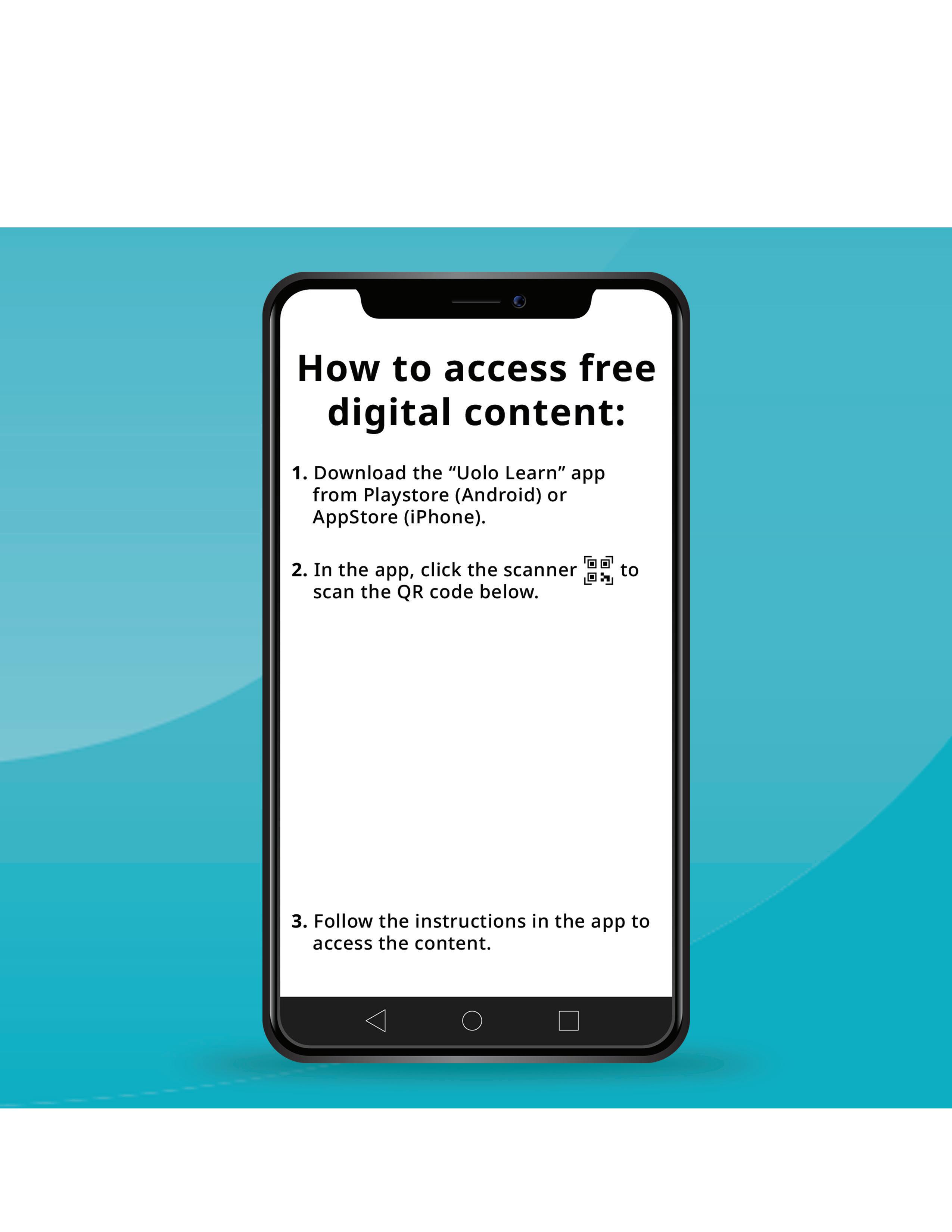
Download now & make learning fun!


Melanie Grobler is a seasoned education professional with experience spanning over three decades in the field of ELT curriculum development and assessment. She has worked in senior advisory positions in India for 10 years and has developed several K-8 ELT products. In South Africa, she served as national examiner for the Class 12 Exit Examination and worked as a teacher, college and university lecturer and subject advisor.

Chandani Goyal is an English Language Teaching (ELT) educator with over 9 years of experience in renowned schools like Heritage Xperiential Learning School, Ahlcon International School and Amity International School. She is also a published author of articles on classroom intervention and pedagogy. She brings a deep understanding of methodology and approaches to language learning into the compilation of this book, enhancing its effectiveness for educators and learners alike.
Academic Authors: Melanie Grobler, Kashika Parnami, Simran Singh, Arpit Agarwal, Simran Nagpal
Book Production: Rakesh Kumar Singh, Tauheed Danish
Project Lead: Chandani Goyal
VP, Learning: Abhishek Bhatnagar
All products and brand names used in this book are trademarks, registered trademarks or trade names of their respective owners.
© Uolo EdTech Private Limited
First edition 2026
This book is sold subject to the condition that it shall not by way of trade or otherwise, be lent, resold, hired out, or otherwise circulated without the publisher’s prior written consent in any form of binding or cover other than that in which it is published and without a similar condition including this condition being imposed on the subsequent purchaser and without limiting the rights under copyright reserved above, no part of this publication may be reproduced, stored in or introduced into a retrieval system, or transmitted in any form or by any means, electronic, mechanical, photocopying, recording or otherwise, without the prior written permission of both the copyright owner and the above-mentioned publisher of this book.
Book Title: Ignite English Grammar Book 4
ISBN: 978-93-89057-07-2
Published by Uolo EdTech Private Limited
Corporate Office Address:
91Springboard, 3rd Floor
145, Sector 44, Gurugram, Haryana 122003
CIN: U74999DL2017PTC322986
Printed by: Kumar Offset Printer
Illustrations and images: www.shutterstock.com, www.stock.adobe.com and www.freepik.com
All suggested use of the internet should be under adult supervision.

In today’s connected world, the ability to use language effectively is more than just a skill—it is a key to meaningful communication, personal expression and academic and professional success. While vocabulary and comprehension form the foundation of language acquisition, it is grammar that gives structure to thought and clarity to expression. However, grammar is best understood—not by memorising rules—but by using it in real situations. When learners experience grammar in context, they are able to apply what they have learnt in their speaking and writing.
Ignite Grammar series is based on the National Education Policy (NEP) 2020 and the National Curriculum Framework (NCF) 2022–23. The programme reimagines how children engage with grammar. It shifts away from decontextualised drills and mechanical exercises to an approach that is contextualised, discovery-driven and embedded in real-life communication. Learners are encouraged to notice patterns in language, infer rules and apply them meaningfully across functional tasks.
This approach not only builds a natural understanding of language and communicative competence but also aligns with the NEP’s vision of nurturing 21st-century skills—critical thinking, creativity, collaboration and effective communication. By providing learners with contexts that are familiar, age-appropriate and socially relevant, Ignite Grammar series supports learners in becoming confident, expressive and skilled communicators.
In keeping with the NEP 2020 and NCF 2022–23, the programme integrates different dimensions of learning that enrich the learners’ overall growth—such as emotional well-being (SEL), cultural rootedness, artistic expression and awareness of Sustainable Development Goals (SDGs). These perspectives ensure that grammar is not learnt in a vacuum, but as part of a broader journey that prepares children to think ethically, collaborate meaningfully, appreciate their heritage and engage actively with the world around them.
Designed with the diverse classroom realities across India in mind, the programme is inclusive and easy to implement. Learners are supported with visual cues and scaffolded learning tasks to ensure that grammar instruction remains purposeful, engaging and accessible. The package comes with digital content, provided free of cost, to ensure a seamless and holistic learning experience for children.
Above all, this grammar series is grounded in the belief that language learning is a lived experience. Grammar is not a set of rules to be remembered—it is a way of making meaning, a toolkit for expressing ideas clearly and creatively.
We extend our warmest wishes to educators, parents and learners as they embark on this journey. May it be filled with enjoyment, exploration, expression and empowerment.
The National Education Policy (NEP) 2020, introduced by the Government of India, represents a transformative shift in the country’s education system. It focusses on building conceptual understanding, skills, values and competencies that align with the demands of the 21st century, while also preserving India’s rich cultural heritage. UOLO is committed to actualising the vision of NEP 2020 by meticulously adhering to its outlined recommendations.











1. Language skills building
2. 21st-century skills, values and dispositions
3. Creative and critical thinking
4. Application in real life

5. Holistic and integrated learning
6. Learning by doing
7. Enjoyment and engagement
8. Collaboration and exploration
9. Technology–based solutions
10. Knowledge of India
11. Assessment of, as and for learning
CompetencyBased Education
NEP Pages 12, 17, 22
Teaching and Learning Pedagogy
NEP Pages 3, 11, 12, 27
National Pride
NEP Pages 15, 16, 43
Assessments
NEP Pages 12, 18, 22
The National Education Policy (NEP) outlines essential skills, values, dispositions and learning approaches necessary for learners to thrive in the 21st century. Ignite Grammar series incorporates these elements throughout. Referred to as ‘NEP Tags’, they are defined as follows:
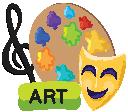

GAMES

INTEGRATED

BHARAT
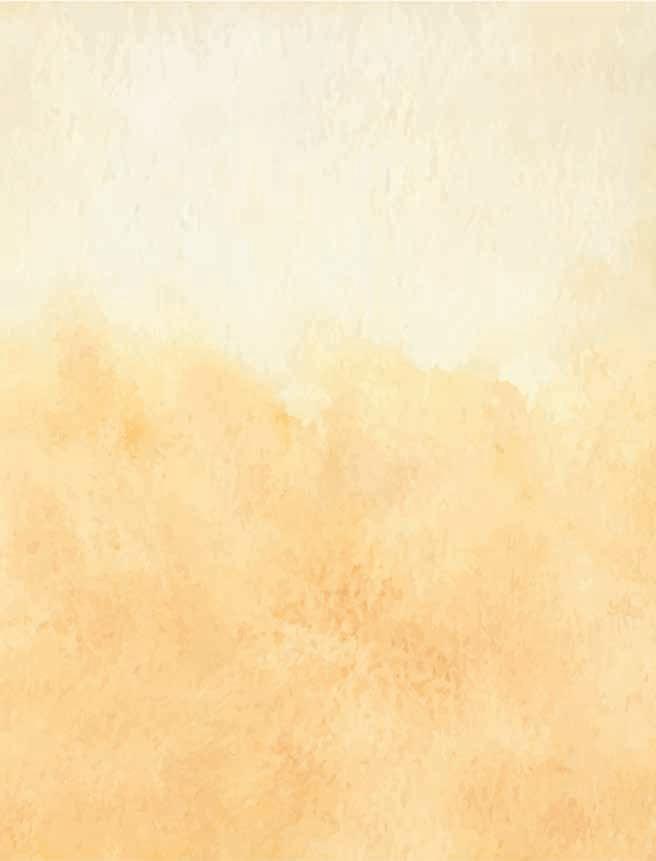
Bringing creativity and fun into learning by combining music, drama and art with other subjects
Using physical activities, sports and games to make learning active and fun
Cross-curricular and skills linkages to make the learning experience more holistic, joyful and meaningful
Texts and tasks are rooted in the Indian context and culture to develop a sense of national pride

TEAMWORK

SDG
SEL

HANDS-ON
Embracing the spirit of mutual collaboration and cooperation while working together or engaging in a guided conversation
Unwavering commitment to generating awareness of a green, peaceful, prosperous, equitable and inclusive world
Developing the skills to understand and manage emotions, build positive relationships and make responsible choices
Engaging actively in hands-on experiences to acquire knowledge and skills
HOTS
Tasks encourage higher-order skills such as analysing, evaluating, problem-solving and fostering deep understanding

Learning Outcome
Learners will be able to:
• identify how abstract nouns differ from common, proper and collective nouns.
Self-Assessment 1 Types of Nouns
• use plural forms ( -s , -es , -ies , -ves and irregular plurals) appropriately in contexts.
• use common, proper, collective and abstract nouns in a range of contexts. 2
• apply knowledge of countable and uncountable nouns in relevant contexts.
• use appr opriate quantifiers ( many , several , few , a few ) with countable nouns and ( much , more , some , little , a little ) with uncountable nouns and recognise that a/an is used only with countable nouns.
Nouns: Number, Gender and Possession
• use gender and possessive nouns ( ’s and s’ ) appropriately in context 3 Countable and Uncountable Nouns
• identify personal (subject and object), interrogative and possessive pronouns and understand their function in sentences
• use the indefinite ar ticles a and an and the definite article the appropriately in subject-related contexts.
4 Types of Pronouns
• use interrogative, possessive and personal pronouns accurately in context. 5
• apply the basic rules for using the meaningfully. Review Test 1
• use adjectives of quality, quantity and number and differentiate them from possessive, interrogative and demonstrative adjectives.
• place adjectives in the correct order within a sentence.
• compare objects using the comparative and superlative forms -er and -est in appropriate contexts.
• use more and most to compare objects when longer adjectives are used or when -er/-est cannot be applied.
• identify that ev ery sentence must have a verb—an action verb, a verb of being ( is , are , am ) or a verb showing possession ( have , has ).
• distinguish between main verbs and helping verbs.
• identify adverbs of manner, frequency, place and time and understand their function in a sentence.
• use adverbs of manner, frequency, place and time accurately in appropriate contexts.
• identify and use prepositions of time and place accurately in different contexts.
• identify and use prepositions of movement accurately in different contexts.
Review Test 2
• use the conjunctions and , but , so , because , when , until , although and that with a clear understanding of their meanings in context.
• join sentences using conjunctions appropriately.
• identify and use previously learnt interjections ( Oh! , Wow! , Yay! , Ah! , Hey! ) appropriately in context.
• recognise and use newly introduced interjections ( Oops! , Ugh! , Phew! , Aha! , Yuck! , Bravo! , Whoa! ) accurately in sentences.
• understand and differentiate the functions of the modals must , can , should , could , may and might
• use these modals in negative and interrogative forms, incorporating contractions where necessary.
• distinguish between complete sentences and non-sentences
• identify subjects, predicates, verbs and objects in given sentences.
• identify declarative, interrogative, imperative and exclamatory sentences and distinguish their purposes.
• use appropriate punctuation marks for each kind of sentence in meaningful contexts.
Review Test 3
• distinguish betw een statements, interrogative and negative sentences.
• for m questions and negative sentences accurately using the simple present (do/does) , simple past (did) and modals, including the use of contractions where appropriate.
6 Types and Order of Adjectives
Adjectives: Degrees of Comparison
7
Verbs
8
Adverbs
9
10 Prepositions
Conjunctions
11
12 Interjections
Modals
13
Subject and Predicate
14
Kinds of Sentences
15
Interrogative and Negative Sentences
16
• use the simple present and present continuous tenses accurately in various meaningful contexts.
• form negative and interrogative sentences in the simple present and present continuous tenses using contractions where necessary.
• identify when to use the past continuous tense and how it differs from the simple past.
• form negative and interrogative sentences in both tenses using contractions where necessary.
• distinguish between the use of the simple future and future continuous tenses.
• form and use negative and interrogative sentences in both tenses appropriately using contractions where necessary.
• ensure that the subject and verb agree with each other in different sentences.

Simple Present and Present Continuous
• use the corr ect verb form with words like and , or , either , neither , each , nobody , everyone , every , several , many , few , a few , both , there , here and some
• use full stops, commas, question marks, exclamation marks and apostrophes correctly in writing.
• use capital letters appr opriately at the beginning of sentences, for the pronoun I and for proper nouns such as days of the week and months of the year.
Review Test 4
• identify collective nouns and match them with the correct group.
• use collective nouns correctly in context.
• identify basic functions of prefixes and suffixes to create new words. • use common prefixes ( -un , -re , -in , -im , -de , -non , -dis , -mis ) and suffixes correctly.
• use antonyms in different contexts.
• form antonyms by adding prefixes like -un , -im , -in , -ir , -ill and -dis and use them in context.
• replace a phrase with one suitable word in different contexts.
• use stronger, more precise words in place of common expressions like very + word.
• identify and use compound words accurately in sentences.
• differentiate between one-word compound words and two-word compound words and use them correctly.
• differentiate between words with similar meanings (synonyms) by identifying their slight differences in meaning or intensity.
• choose and use words with the most appropriate shade of meaning in different contexts.
Simple Past and Past Continuous
18
Simple Future and Future Continuous
19
20 Subject-Verb Agreement
21 Punctuation
Vocabulary 1: Collective Noun
Vocabulary 2: Prefixes and Suffixes
Vocabulary 3: Antonyms
Vocabulary 4: One Word for a Phrase
Vocabulary 5: Compound Words
Vocabulary 6: Shades of Meaning
Reading Comprehension–1
Reading Comprehension–2
Reading Comprehension–3
Reading Comprehension–4
• write an informal message to someone to give information clearly and briefly.
• use correct format, complete sentences and relevant details.
• write a notice based on prompts, with key details like what, when, where and who.
• follow the proper format to write the notice.
• write a short paragraph on a topic with given prompts.
• use correct sentence structure to express ideas.
• write a simple informal letter using prompts.
• organise ideas in the correct format.
• write a short story using a picture or cartoon or given prompts.
• organise ideas into beginning, middle and end using descriptive language and expressions and give a suitable title.
• write a short essay with a clear introduction, body and conclusion based on a given topic.
• express ideas in a logical order using linking words and supporting details.
Writing 1: Message
Writing 2: Notice Writing
Writing 3: Paragraph Writing
Writing 4: Informal Letter
Writing 5: Story Writing
Writing 6: Essay Writing
Answer Key
1



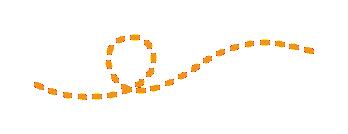
the conversation between Avani and Reyaan.
Avani: Did you see Rakesh Sir leading his group of students down to the field?
Reyaan: Yes! Their basketball team showed great sportsmanship during the game
Avani: I liked their determination; they did not give up even when it was tough.



Avani: Yes, that class really has great spirit












Read the conversation between Avani and Reyaan.
Avani: Did you see Rakesh Sir leading his group of students down to the field?

Reyaan: Yes! Their basketball team showed great sportsmanship during the game
Interjections are words that help us express emotions
How It Works

Avani: I liked their determination; they did not give up even when it was tough.
Read the conversation between Avani and Reyaan.
Interjections are words that help us express emotions
For example: Hurray! I won the game. (happiness) Hey! Be careful. (attention grabber)
For example: Hurray! I won the game. (happiness) Hey! Be careful. (attention grabber) Oh no! I lost my book. (sadness) Umm, I am not sure. (hesitation, uncertainty) Aha, I understand. (realisation)
Interjections are often followed by an exclamation mark They can also be followed by a comma (,) or a question based on the emotion being expressed.
Oh no! I lost my book. (sadness) Umm, I am not sure. (hesitation, uncertainty) Aha, I understand. (realisation)
Get Set: A short and engaging warm-up to spark observation and set the context for learning
Interjections are often followed by an exclamation mark (!) They can also be followed by a comma (,) or a question mark (?) based on the emotion being expressed.
Reyaan: I liked seeing the joy and excitement of their classmates when they finally won.
Avani: Yes, that class really has great spirit
Avani: Did you see Rakesh Sir leading his group of students down to the field?
Think about and discuss these questions.
Reyaan: Yes! Their basketball team showed great sportsmanship during the game
For example: Hmm, I think the answer is 45. (thinking) Really? You made it! (disbelief) Wow, that’s interesting.
For example: Hmm, I think the answer is 45. (thinking) Really? You made it! (disbelief) Wow, that’s interesting.
Let us look at some common interjections and the emotions
Interjection
1. The words in green are common and special nouns. Which one of them is a special noun?
2. Which other special nouns can you find in the text? Look at who are speaking the dialogue.
Discussion Questions: Guided prompts to help learners reflect, observe and prepare for concept discovery
Hurray! Wow! Bravo! Yay! Great! Aha! Oh!
3. Which words show a group of people as one unit?
Avani: I liked their determination; they did not give up even when it was tough.
4. Are the words in red objects? Can you physically touch them and see them?
Reyaan: I liked seeing the joy and excitement of their classmates when they finally won.
How It Works: Concept explanation through relatable examples and visuals that show grammar in use
Avani: Yes, that class really has great spirit
Think about and discuss these questions.
Interjections are words that help us express emotions
Ouch! Ow!
Oh! What! Whoa!
Yuck! Eww! Ugh! Alas! Oh no! Oops!
1. The words in green are common and special nouns. Which one of them is a special noun?
Reyaan: I liked seeing the joy and excitement of their classmates when they finally won.
Hey! Look! Listen!
We already know the three types of nouns—common nouns, special nouns and collective nouns.
3. Which words show a group of people as one unit?
Let us look at some common interjections and the emotions they express. Interjection Emotion Expressed Hurray! Wow! Bravo! Yay! Great! joy/happiness Aha! Oh! realisation Ouch! Ow! pain Oh! What! Whoa! surprise/shock Yuck! Eww! Ugh! disgust/dislike Alas! Oh no! Oops! sadness/regret Hey! Look! Listen! urgency/attention grabber Hmm, Err, Mmm thought/hesitation What? Eh? Huh? Really? confusion/uncertainty Phew! Ah!
Common Nouns: These are names of any person, place, animal or thing.
about and discuss these questions. words in green are common and special nouns. Which one of them is a special noun?
Fun with Grammar: Interactive activity/game that enables learners to explore grammar through hands-on play and real-time collaboration
Which words show a group of people as one unit? the words in red objects? Can you physically touch them and see them?
4. Are the words in red objects? Can you physically touch them and see them?
For example: Hurray! I won the game. (happiness) Hey! Be careful. (attention grabber) Oh no! I lost my book. (sadness) Umm, I am not sure. (hesitation, uncertainty) Aha, I understand. (realisation)
2. Which other special nouns can you find in the text? Look at who are speaking the dialogue.
Hmm, Err, Mmm What? Eh? Huh? Really?
Remember! When an interjection stands alone and has an exclamation
Phew! Ah!


Fun with Grammar
Chapter 1 • Types of Nouns
Which other special nouns can you find in the text? Look at who are speaking the dialogue.
Interjections are often followed by an They can also be followed by a based on the emotion being expressed.
Interjection Charades
1. Divide the class into two teams (A and B).
We already know the three types of nouns—common nouns, special nouns and collective nouns.
NEP Tags: To showcase alignment with NEP skills and values
already know the three types of nouns—common nouns, special nouns and collective nouns.
2. Prepare chits with interjections: Wow! Ouch! Yuck! Oh no! Hurray! Hey! Alas! etc.




• Types of Nouns

Common Nouns: These are names of any person, place, animal or thing.
Time

Common Nouns: These are names of any person, place, animal or thing.
For example: Hmm, I think the answer is 45. (thinking) Really? You made it! (disbelief) Wow, that’s interesting.
Chapter 1 • Types of Nouns

Use It for Real


1. Divide the class into two teams (A and B).
Chapter 12 • Interjections
Let us look at some common interjections and the emotions they express.
2. Prepare chits with interjections: Wow! Ouch! Yuck! Oh no! Hurray! Hey! Alas! etc.
Interjection Hurray! Wow! Bravo! Yay! Great! joy/happiness realisation


Fun with Grammar Time
Ouch! Ow! pain
Chapter 12 • Interjections
Oh! What! Whoa! surprise/shock

Yuck! Eww! Ugh! disgust/dislike

Let’s meet at 4 o’clock. at I will meet you on Monday. on The sun rises in the morning. in

QR Code: Interactive quizzes for learners to practise
Alas! Oh no! Oops! sadness/regret Hey! Look! Listen! urgency/attention grabber Hmm, Err, Mmm thought/hesitation What? Eh? Huh? Really? confusion/uncertainty
Use It for Real: Practice tasks rooted in real-life contexts to help learners apply grammar meaningfully across situations you can count. One has been done for you. ribbons oil shoes water pens bags picnic basket. Draw two countable foods and two you can pack. Also, write their names.
Let’s meet at 4 o’clock. at I will meet you on Monday. The sun morning.

1. Match the following. One has been done for you.
(a) We can • • help our teacher.
(c) We should
(d) We shouldn’t
Error Alert! Highlights common learner mistakes to reinforce accurate grammar usage
Error Alert!
Interjection Charades
(b) We can’t • • push our friends.
1. Divide the class into two teams (A and B).



Let’s meet at 4 o’clock. at I will meet you on Monday. on The sun rises in the morning. in atUse at for the exact time. I go to school at 8 o’clock. on Use on for the day or date My birthday is on 2 July.
atUse at for the exact time. I go to school at 8 on Use on for the day or date My birthday is on

• lift heavy boxes.
atUse at for the exact time. I go to school at 8 o’clock. on Use on for the day or date
2. Prepare chits with interjections: Wow! Ouch! Yuck! Oh no! Hurray! Hey! Alas! etc.
• all swim well.
inUse in for a broad time in a day.We play in the evening.
Error Alert!
My birthday is on 2 July.
2. Fill in the blanks with can or can’t.
inUse in for a broad time in a day.We play in the evening.
Uncountable
inUse in for a broad time in a day.We play in the evening.
Error Alert!
(a) Most birds fly.
(b) Birds swim underwater like fish.
(c) Ostriches run very fast.
(d) Penguins fly like other birds.
Remember! Gives learners key takeaways and important rules to keep in mind for quick recall
(e) Parrots talk and copy sounds.
We use in with morning, afternoon, and evening but NOT with night. For example: I go to school in the morning. We play in the afternoon. We rest in the evening. We sleep at night.
3. Fill in the blanks with should or shouldn’t.
We use in with morning, afternoon, and evening but NOT with night. For example: I go to school in the morning. We play in the afternoon. We rest in the evening. We sleep at night. Time
We use in with morning, afternoon, and evening but NOT with night. For example: I go to school in the morning. We play in the afternoon. We rest in the evening. We sleep at night.
Some position words can be used to show both place and time like at …at school …at 3:30
Think and Tell: Thinking prompts and questions for teachers to assess learners’ attention and understanding of concepts
Think and Tell Remember!
(a) We throw plastic bottles in the ocean.
(b) We clean up garbage on the beach.
Think and Tell Remember!
(c) People use less plastic.
Some position words can be used to show both place and time like at …at school …at 3:30

Look around you. What is in front of you?
Look around you. What is in front of you?
Fun with Grammar

(d) We leave food wrappers behind.

Think and Tell Remember!
Some position used to show time like at …at school …at
Look around you. front of you?




1. Fill in the blanks with the correct pronouns.
(a) The mosquito is hungr y. buzzes around Satish’s room.
(personal)
(b) Satish is sleeping under a net. does not move.
(personal)
(c) Satish’s mother bought the net to protect .
(d) The net belongs to Satish. It is
(personal)
(possessive)

(e) Satish’s mother checks on him. ‘These mosquitoes are everywhere!
Luckily cannot bite Satish!’
(personal)
2. Choose the correct present tense verb to fill in the blanks.
(a) The biggest mosquito (sits / sitting) on the net looking at Satish.
(b) ‘Those little arms (looks / look) very tasty,’ thinks the mosquito.
(c) ‘I (am / are) smarter than my friends. I must get into the net,’ the mosquito says.
(d) Satish (don’t / doesn’t) even know about the mosquito, because he (is / are) far away in dreamland.
3. Fill in the blanks with correct prepositions.
(a) Another mosquito buzzes (beside / around / on) the room, looking for its chance.
(b) The mosquito net is (under / over / beside) Satish’s bed, so that mosquitoes cannot get in.
(c) This mosquito also looks (on / in / at) Satish hungrily.

(d) Satish is safe (inside / outside / between) his net.
(e) Finally, the mosquito gives up and buzzes (in / out of / into) the room.

4. Read the passage and answer the writing question. Satish’s teacher spoke about how students can help to stop dengue from spreading. She said, ‘To stop dengue, we should keep our homes clean. Mosquitoes live in dirty water. If we work together, we can stay safe. We shouldn’t leave containers with water in them for long. We can also sleep under a net and use an ointment or spray to keep mosquitoes away. In this way mosquitoes can’t bite and infect us.
Write FIVE sentences about what we can do to stop colds and flu from spreading at school. Use can, can’t, should and shouldn’t in your sentences. Use the correct punctuation marks.
5. Today, you saw an old man carrying a heavy bag of fruit and vegetables. You reached out to help him. You feel proud of yourself. Write a diary entry using past tense telling your diary what happened, what you did and how you felt.
(date) (time) (day)
Dear Diary, Love,
(name)









Read the conversation between Avani and Reyaan.
Avani: Did you see Rakesh Sir leading his group of students down to the field?
Reyaan: Yes! Their basketball team showed great sportsmanship during the game.
Avani: I liked their determination; they did not give up even when it was tough.
Reyaan: I liked seeing the joy and excitement of their classmates when they finally won.
Avani: Yes, that class really has great spirit.
Think about and discuss these questions.
1. The words in green are common and special nouns. Which one of them is a special noun?
2. Which other special nouns can you find in the text? Look at who are speaking the dialogue.
3. Which words show a group of people as one unit?
4. Are the words in red objects? Can you physically touch them and see them?

We already know the three types of nouns—common nouns, special nouns and collective nouns.
Common Nouns: These are names of any person, place, animal or thing.
For example: There are many students on the field. All their classmates came to watch the game
Proper Nouns: These are special and specific names of people, places, animals or things. They always begin with a capital letter.
For example: Rakesh Sir is a good teacher. Step-Up Primary is in Raipur. Special names given to states, cities, countries, roads, mountains, festivals, rivers, newspapers and books are also proper nouns.
States, Cities and Countries and Roads:
Mumbai is a city in Maharashtra, India. The Grand Trunk Road is very long.
Building, Monuments and Towers:
Hawa Mahal is a beautiful palace in Jaipur.
Festivals:
Ganesh Chaturthi is usually celebrated for ten days.
Newspapers and Books:
I read about The Jungle Book in The Times of India.
Rivers:
The Brahmaputra River is very wide and powerful.
Days and Months:
My plan is to meet them on the first Saturday of January.
Special Days:
Teachers’ Day is celebrated on 5 September.
Goods/Companies:
Amul produces milk and dairy products in India.
Collective Nouns: These name a group of people, animals or things. For example: A group/class of students goes to the field. A gaggle of geese walks together.
Note: Refer to page no. 103 for a list of collective nouns.
Now, let’s learn about abstract noun.
Abstract Nouns: These are feelings, ideas or qualities. You can’t see or touch them. For example: The team showed sportsmanship and determination. You could see the joy and excitement on their faces. It was Rakesh Sir’s idea to lead the team to the field.

1. Divide yourselves in teams of 3 or 4.
2. Take a sheet and make a table as shown below.

The Anamudi is the highest mountain peak in South India.
LetterName Place/River/Mountain Animal/InsectThingIdeaScore

3. Your teacher will give one letter of the alphabet at a time, and each team will fill in the table with nouns starting with that letter.
4. The team that finishes first, says ‘Stop’ and everyone stops writing. The first team to finish, writes their words on the board. If the words are correct, they get a score of 5 (one mark for each word). The other teams write their scores depending on how many correct words they wrote.


1. Tick (✓) the correct type of noun for the underlined word in each sentence. One has been done for you.
(a) Our class went on a trip to Qutb Minar.
• Proper Noun
• Collective Noun • Abstract Noun
(b) The guide told us interesting facts about the monument.
• Common Noun
• Proper Noun • Abstract Noun
(c) We were amazed at his knowledge of history.
• Common Noun
• Collective Noun • Abstract Noun
(d) My friend Aarav took lots of photos.
• Proper Noun
• Common Noun • Abstract Noun
(e) Qutb Minar is a famous monument in Delhi.
• Collective Noun

• Proper Noun • Common Noun
2. Underline the abstract noun (feelings, ideas or qualities) in each sentence.
(a) My grandma and I made a scrapbook filled with memories of our vacation.
(b) I felt great excitement while decorating the first page.
(c) Grandma sorted the photos with love.
(d) We worked together in peace.
(e) Our creativity made the scrapbook look amazing.

3. Fill in the blanks with the given abstract nouns.
strength teamwork excitement courage determination
(a) The players needed to pull the rope.
(b) Good helped them win the game.
(c) There was loud cheering and all around.
(d) When it seemed one team would lose, they found the to fight on bravely.
(e) It took to keep trying and not to give up.
4. In your notebook, make sentences using these abstract nouns. fear joy trust kindness hope
5. Fill in the blanks with the correct nouns.
Delhi group thrill family clouds Nishant officers airhostess passengers
Last summer, (a) travelled by aeroplane for the first time with his (b) . At the airport, many (c) were waiting in a queue. The (d) checked their tickets and wished them a safe journey. On the plane, the (e) greeted everyone politely. From the window, they saw white (f) and a shining blue sky. After some time, the aeroplane flew above (g) , and everything looked tiny below. The whole (h) felt the (i) of being on the way to a different place.
(proper noun)
(collective noun) (common noun)
(common noun)
(common noun)
(common noun) (proper noun)
(collective noun)
(abstract noun)
6. Write a short paragraph (FIVE sentences) about a family trip using at least one of each type of noun: common, proper, collective and abstract. After writing, underline each noun and label it in brackets.








Read about Meher’s visit to the museum. Meher and her friends visited a museum last Sunday. They saw many paintings, sketches and statues. The children’s guide, Mrs Kapoor, showed them artists’ work from different centuries. Meher took photos of a dinosaur’s bones and an oxen’s horns displayed in glass cases.
In the history section, the men’s clothes and the ladies’ dresses from ancient times interested everyone. There were even cloaks made from the furs of wolves. The boys were interested in the soldiers’ swords while the girls were interested in the jewellery worn by the kings and queens.
The museum’s exhibits included boxes, diaries, compasses and clay dishes. The assistant told us about scientists and explorers. Everyone enjoyed the stories they heard about the lives of ancient men and women.
Think about and discuss these questions.
1. Which words are used for more than one painting, sketch and statue? What do we call words that refer to more than one person, place, thing or animal?
2. Which words in the text are used only for males? And only for females?
3. Do the words scientist, assistant and explorer refer only to males or females?
4. What does the apostrophe in the following phrases show—the children’s guide, artists’ work, an oxen’s horns and women’s dresses?

We know that nouns name people, places, things and animals.
Nouns can also show singular and plural, whether the noun is male or female (gender) and ownership (possession).
Nouns can be singular (one) or plural (more than one).
Regular plurals are those that end in -s or -es.
Add -s friend – friends painting – paintings statue – statues photo – photos
Add -es for words ending in -s, -x, -ch, -sh, -z sketch – sketches
compass – compasses dish – dishes box – boxes
Irregular plurals change completely.
Change -y to -ies (when there is a consonant before the y); add -s (when there is a vowel before the -y)
century – centuries diary – diaries
discovery – discoveries
story – stories
key – keys boy – boys
Change -f or -fe to -ves wolf – wolves life – lives
man – men woman – women child – children person – people ox – oxen mouse – mice foot – feet goose – geese tooth – teeth
Zero plurals stay the same in their singular or plural form. sheep – sheep deer – deer aircraft – aircraft spacecraft – spacecraft
Error Alert!
Fish does not take a plural unless you are talking about different kinds. For example: There are ten fish here. (same kind)
The aquarium has many fishes from around the world. (different kinds)
Gender tells us if the noun is male, female or neutral.
• Masculine: boy, king, men
• Feminine: girl, queen, women


• Common Gender (can be male or female): guide, artist, scientist, assistant, explorer
• Neuter (non-living things): museum, sketch, statue


Let us look at some more examples.
Masculine and Feminine (People)
host – hostess
Masculine and Feminine (Animals)
Common GenderNeuter
ram (sheep) – ewe soldier photo
hero – heroine tiger – tigress teacher box
wizard – witch tomcat – queen doctor cloak
gentleman – lady lion – lioness friend coin
heir – heiress cock – hen parent diary
actor – actress fox – vixen cousin belt
niece – nephew
billy goat – nanny goatathlete fur
landlord – landladybuck (deer) – doe nurse dish
• For singular nouns, add ’s : the dinosaur’s bones the museum’s exhibits the guide’s assistant Tejas’s school
• For plural nouns that already end in s, just add ’ : the artists’ work the knights’ shields the ladies’ dresses
• For plural nouns that do not end in s, add ’s : The children’s guide oxen’s horns men’s armour


1. Play in teams of four.
2. Two students in the team will make slips with these words on them – Arpit, Sonja, The coach, The players, The umpire, The coaches, The player and The captain. Put these slips in one pile.
3. The other two students will make slips with these words – ball, gloves, turn, bat, racket, uniform, shoes and score. Put these slips in another pile.
4. Now, play the game. Mix up the slips in each of the piles.
5. Each player takes a turn to pick up a slip from each pile. Use the information on the slips to write who the objects belong to. For example: Arpit gloves = Arpit’s gloves
6. The team checks what each player has written and corrects if necessary.
7. The team that has used all the slips and has written eight correct sentences wins.
1. Write a summary of the rules on the board
2. Once all the teams have finished give the correct answers.












s





• Singular nouns • Plural nouns that end in -s


• Plural nouns that don’t end in -s










1. Write the plural form of each noun. One has been done for you.
(a) brush → brushes
(c) tomato →
(e) city →
(g) donkey →
(i) child →
(k) scarf →
(b) hero →
(d) knife →
(f) mouse →
(h) church →
(j) half →
(l) quiz →
2. Read each noun and underline its correct gender.
(a) empress – (Masculine / Feminine / Common / Neuter)
(b) pencil – (Masculine / Feminine / Common / Neuter)
(c) uncle – (Masculine / Feminine / Common / Neuter)
(d) carpenter – (Masculine / Feminine / Common / Neuter)
(e) lioness – (Masculine / Feminine / Common / Neuter)
(f) table – (Masculine / Feminine / Common / Neuter)
(g) student – (Masculine / Feminine / Common / Neuter)
(h) king – (Masculine / Feminine / Common / Neuter)
3. Rewrite each sentence using the possessive form of the noun in bold.
(a) The dog tail is wagging.
(b) The girls uniforms are blue.
(c) The child toy is broken.





(d) The men boots are muddy.
(e) The students books are on the table.

4. Fill in the blanks with the correct plural form of the words in brackets.
(a) The artist mixed bright (colour) on her palette.
(b) There were many (canvas) hanging on the wall.
(c) Anuj drew three (lady) standing next to each other.
(d) Monika painted orange and red (leaf) on the tree.
(e) The (child) displayed their artwork on the walls.
5. Rewrite the paragraph by changing the gender of the nouns in bold. Make other necessary changes.
The king went hunting in the forest with his daughter. Many soldiers joined them. They saw a fierce lioness chasing a buck. They met a kind man who was a village teacher. The brave princess told him that her horse was faster than the wind.
Remember!
Common gender nouns will not change.

6. Fill in the blanks with the correct form of the nouns in brackets.
Our school celebrated (a) (Mother) Day. Children made beautiful (b) (card) for their moms. Some children drew colourful pictures of their (c) (family) while others drew (d) (fairy) and flowers.
A class helper cut out paper (e) (leaf) and shaped them into hearts. A kind lady came to deliver (f) (box) of chocolates and (g) (scarf) as gifts for the mothers. Everyone admired the (h) (teacher) decorations outside their classrooms. Our (i) (class) excitement grew as our mothers came in. The principal praised (j) (everyone) efforts to make the day a success.








Look at the list of items in the picnic basket.
Kiyana has packed for a family picnic. She checks the items in her basket.
• Two sandwiches
• Mustard sauce • A loaf of bread
• Some juice • A few apples • A little butter
• A few cookies • A little salt
Think about and discuss these questions.
1. Which items in the basket can you count?
• Some cheese
2. Which items in the basket cannot be counted?

Countable nouns are things that can be counted as individual items.
Uncountable nouns cannot be counted individually because they are seen as a whole or a mass.
For example:
Countable Nouns
• Kiyana has packed two sandwiches.
• There are a few apples in the basket.
• She has a few cookies.
• She also has a loaf of bread.
Uncountable Nouns
• Kiyana has mustard sauce.
• She also has some juice.
• There is a little butter
• She packed some salt.



Quantifiers are words used before nouns to say how much or how many things there are.
Quantifiers used with countable nouns:
Quantifier Meaning Example
fewa very small number (negative feeling) Few children came to school today. a fewa small number (but enough) I have a few pencils to share. severalmore than two, but not many She has several toys at home. some an unknown number (more than one, but not all) Some students are absent.
manya large number
There are many books in the library. morea greater number than before Can we get more chairs?
Quantifiers used with uncountable nouns:
Quantifier Meaning Example
mucha large amount
There isn’t much juice left. littlea very small amount (negative feeling) We have little sugar at home. a little a small amount (but enough) There is a little milk in the glass. somean unknown amount (more than none) Please put some butter on the toast. morea greater amount than before I need more water.
A/an can only be used with countable nouns, not uncountable nouns. We do not say a sugar or a milk.

1. Work in pairs. Take turns to name what you see in the fridge.
2. Use a different word from the box with each item you name.
A number (three) many several few a few much some little a little
For example: I see seven eggs. I see some milk.



1. Write each noun in the correct column.
Nouns: rice, a bag of rice, oranges, book, tea, sugar, a spoon of sugar, pencil, milk, liquid, eggs, sand
Countable Nouns
Uncountable Nouns

2. Tick (✓) the correct phrase to fill in the blank.
(a) I needed for my apple pie.
• several ingredients
• a little ingredients
(b) We used to mix into the batter.
• a milk
• some milk
(c) I chopped for the pie.
• a few apples


• a little apples
(d) There were on the table.
• much bowls
• many bowls
(e) I poured into a bowl.
• some batter
• a batter
(f) I ate as a snack while waiting for the cake to bake.
• a banana
• much banana

3. Read each sentence and underline the correct quantifier.
(a) We needed (a / an / some) screwdriver to tighten the screws of the robot.
(b) We used (many / much / a little) wires to connect the parts.
(c) There were (few / a few / little) mistakes the first time we tried.
(d) We had (a little / few / many) time left, so we fixed what we could.
(e) (Several / Much / Little) students helped to program the robot’s movements.

4. Fill in each blank with the correct quantifier from the box.
a many a few some a little
(a) We learnt interesting facts about pandas in class today.
(b) Pandas eat bamboo and only other types of food.
(c) A panda can eat up to 38 kilograms of bamboo in day!
(d) There are not wild pandas left in the world.
(e) Because bamboo has a lot of water, pandas only drink water from streams.
5. Imagine you are Ashish. You are packing your bag for a trip. Use the sentence starters to write six sentences about the things that you packed. Use at least four quantifiers in your sentences.
I was so excited about going on holiday that I started packing the day before.
• I decided to take
• I also took
• My mom said that I must pack
• My sister wanted me to take
• Dad said that we needed
• Then I remembered I still needed
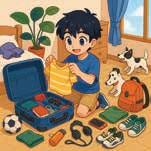








Read the questions and answers about the picture.
What is Anita doing?
She is reading her book. Why is Amit raising his hand?
He wants to borrow the dictionary. He does not have his Is the book in Sumit’s hand Rumi’s or his?
It is his. He is lending it to her.
Whose is this lunchbox?
That is hers (Rumi’s).
Think about and discuss these questions.
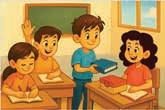
1. To which children do the words She and He in the text refer?
2. Why don’t we repeat the names instead of using He and She?
3. What is the common purpose of the words—what, why and whose?
4. What do the pronouns in blue (his and hers) show?

Pronouns are words that we use in place of nouns. We use pronouns so that we do not repeat the naming words again and again. Pronouns help us understand who and what we are talking about.
For example: Anita is my friend. Anita is kind. Anita is my friend. She is kind.
These pronouns are used in place of people, animals or things. They can be used as subjects (who do the action) or objects (who receive the action).
Subject Pronouns
I, he, she, it, you, we and they They tell us who or what is doing the action and usually come at the beginning of a sentence.
Object Pronouns
Me, him, her, it, you, us and them
They come after the verb and show who receives the action.
For example: He (Sumit) is lending it to her (Rumi).
She (Rumi) takes it from him (Sumit).
subject pronouns object pronouns
Personal pronouns are of three kinds and can be used for singular or plural.
Type
First Person Pronoun
It is used for the speaker.
Singular
I, me I need a dictionary. Give the dictionary to me.
Second Person Pronoun
It is used for the listener or the person spoken to.
Third Person Pronoun
It is used for a person other than the speaker.
You
You like to read books.
The teacher gave the book to you.
He, him, she, her, it
He gives the dictionary to her. She lends the book to him. It (The book) is very interesting. Please give it (the dictionary) to her.
You and I will help them. You will help me. You and me will help them. You will help I.
Plural
We, us
We need the dictionary. Can you give us the dictionary?
You
Students, you all are very helpful.
They, them
They need a dictionary. It helps them understand the words better.
Subject Object I is a subject pronoun. Me is an object pronoun that comes after the verb.
Mine, his, hers, its, yours, ours and theirs show that something belongs to someone. It replaces a possessive noun or phrase that shows possession.
For example: Is the book Rumi’s or his? Sumit’s a book belonging to Sumit
The class is theirs students’ class belonging to students
Note: Possessive pronouns are not followed by nouns–they stand alone and usually appear at the end of a sentence.
These pronouns are used to ask questions.
Interrogative PronounsUsed to Ask About Examples who a person (subject) Who is helping in the kitchen? whose shows possession Whose is this book? what a thing What is in the lunchbox? which a choice Which is your dog? whom a person (object) To whom are you giving the book?
Note: Use who when you can answer the question with he, she, they. Use whom when you can answer the question with him, her, them


Across
1. A pronoun used to ask about a thing
2. Belonging to ‘her’
Down
3. Belonging to ‘you’
4. An interrogative pronoun for ‘a person’
5. Belonging to ‘them’

1. Fill in the blanks with possessive pronouns from the box. mine hers his theirs yours
(a) That pencil is not yours. It is .
(b) This tiffin box belongs to Arjun. It is .
(c) Those crayons belong to Meena and Ritu. They are .
(d) Is that bag or mine?
(e) I brought these storybooks. These are .

2. Complete the questions using the interrogative pronouns from the box. who whose which whom what
(a) gave you this gift?
(b) is your favourite balloon—the red or the blue?
(c) is that bag lying under the chair?
(d) are you inviting to the party?
(e) is inside the big blue box?
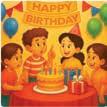
3. Read the scene given in first person personal pronoun. Rewrite the scene using the second and third person personal pronouns.
I went to the old age home with my classmates. I sang songs for the grandparents and talked to them. I felt happy when I saw them smile.
Second Person Pronoun
Third Person Pronoun

4. Replace the underlined nouns with the correct personal or possessive pronouns. Rewrite the sentences.
(a) Ritu and I went to play. .
(b) The ball hit Tina. .

(c) The red shoes are Tina’s. .
(d) Rahul helped Tina get up. .
(e) The coach gave the children water. .
5. Complete the diary entry by filling in the blanks with the correct pronouns.
(date) (time) (day)
Dear Diary,
Today was a busy and fun day! In the morning, helped my mother cook breakfast. Then, visited my friend Surabhi. gave me a beautiful handmade card. Later, went to the park together. wanted to play on the roundabout but was broken. We found two cute puppies and had fun playing with . were those puppies? didn’t know. But were very friendly. They barked when we ran around with . On my way home, saw a girl sitting on a bench. was reading a book. Perhaps the puppies were . I hope we see those cute puppies again!
Love,
(your name)








Read the conversation aloud.
Ayaan and Rina are in the garden.
Rina: What are you hiding behind your back, Ayaan?
Ayaan: Guess! It’s a basket with snacks for us.
Rina: I can smell something yummy! Is that an orange I see?
Ayaan: Yes, I also have a banana, a sandwich, cream rolls and a bottle of juice.
Rina: Let’s eat! I’m hungry!
Ayaan: Wait! A cream roll is missing! There were three!
Rina: Look! A monkey is running away with it!
Ayaan: Oh no! That was the best cream roll!
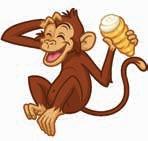
We use a or an to show any person, place, animal or thing. We use the to talk about something or someone we know.
Rina: Haha! That monkey is running as fast as the Rajdhani Express! Next time, use a cloth to cover the basket!
Think about and discuss these questions.
1. Which word/s do we use when we talk about something for the first time – a, an or the?
2. How many cream rolls go missing? How do you know?
3. Why does Ayaan say, ‘the best cream roll’ and not ‘a best cream roll’?
4. In what way are all the highlighted words similar?

The highlighted words a, an and the are called articles. They are used before nouns. There are two types of articles:
Indefinite Articles—A and An
We use a or an when we talk about any one person, place, animal or thing, not a special or known one. They are used to introduce a noun for the first time. For example: I saw a monkey in the garden.
He has an orange in the basket.

We use a before a consonant sound. For example: I want to eat a sandwich. We use an before words that begin with a vowel sound (a,e,i,o,u) and not a vowel letter.
For example: I am an hour late for my flight to a European country.
We use the:
when we talk about something already mentioned
A cream roll is missing. It was the best cream roll. when the person or thing is special, known or the only one.
The Yamuna is one of the most sacred rivers of India.
The Kanchenjunga is the third-highest mountain in the world.
The Mysuru Palace is a famous monument in Karnataka.
The Ramayana tells the story of Lord Rama.
That monkey is running as fast as the Rajdhani Express. with names of rivers, mountains, famous places, books, nationalities, celestial bodies, etc.
The Indians celebrate their festivals with joy.
The sun is shining.
We do not use the before the name of people, cities, countries, uncountable nouns or even ideas/qualities. Wrong: The Rabindranath Tagore was a poet from the Kolkata
Correct: Rabindranath Tagore was a poet from Kolkata.
Wrong: The kindness is a virtue.
Correct: Kindness is a virtue.




1. Play in a group.
2. Roll the dice once to choose a character from the chart. Roll again to get the setting.
3. Make up a 4–5 line story. Take care to get the articles right!
4. For example: Let’s say you roll a 3 and a 1. • Character: a spy
a hospital
5. Share your story with your group.
A spy walked into a hospital pretending to be a visitor. She found the room where a secret file was hidden behind an old cupboard. Before she could find it, a doctor appeared. She pretended to be lost and left. She would have to come back later.

1. Fill in the blanks with the correct articles.
(a) We joined campaign by government to save dolphins from plastic waste.
(b) diver rescued turtle caught in fishing net.

(c) Scientists are studying ways to protect oceans.
(d) Volunteers cleaned beach and found bag full of plastic.
(e) The government has also started project to save whales.
(f) clean-up campaign was great success.





2. Read the passage about what Rohan learnt during the day. Fill in the blanks with the correct articles.
Today, Rohan learnt many things at school.
Rohan read about (a) Great Sphinx of Giza in his history book. He also saw a picture of (b) igloo, which people build in very cold places. His science teacher told him about (c) planet Mars, where astronauts dream to travel one day. On the way home, Rohan met (d) eighteen-year-old boy who was selling books. He also saw (e) parrot sitting in a tree. Suddenly, he realised he was (f) hour late and he had to run home. That night, his father told him a story about (g) Yellow River in China.
3. In your notebook, rewrite the sentences by adding the correct articles.
(a) Asiatic lion lives in Gir Forest in India.
(b) Lion is strong animal with loud roar.
(c) While visiting forest, we saw lion resting under tree.
(d) Tourist took photo of cub playing in grass.
(e) Forest guard told us exciting story about huge lion and angry snake.
Time: 40 mins
Total: 25 Marks
1. Fill in the blanks with the correct nouns from the box. Look at the clues given. (5 × 1 = 5 marks) money danger monk India fleet
Long ago, on the Konkan coast of (a) , there was a rocky island in the sea. Boats couldn’t see the dangerous rocks at high tide, and many ships crashed into them.
(proper noun)

A kind (b) named Swami Anant, put a brass bell on the rocks. When the waves hit the bell, the sound warned ships of the (c) .
(common noun)
(abstract noun)
A trader named Raghav Seth, who thought he could make (d) by selling it stole the bell. When his (e) of ships travelled the same route a year later, two of his ships struck those rocks and sank. It was a big lesson for him.
(collective noun)
(common noun)
2. Fill in the blanks with the correct plural or possessive form of the nouns. (5 × 1 = 5 marks)
(a) Akshit and Mira were excited about their idea of going on a day trip. (fathers / father’s / fathers’)
(b) The backpacks were filled with toys and snacks. (children / childrens / children’s)
(c) While playing, some of Mira’s fell out of the car window. (toys / toy’s / toys’)
(d) Akshit played so wildly that his frames broke. (glasses / glasses’s / glasses’)
(e) Their sigh was loud when they reached the rest stop. (mothers / mother’s / mothers’)
3. Fill in the blanks with the correct words. (5 × 1 = 5 marks)
(a) I have (a few / little) idlis on my plate.
(b) There is (some / many) sambar in the bowl.

(c) (Much / Many) people are eating dosas in the restaurant.
(d) There is (a little / few) coconut chutney left in the bowl.
(e) There are (much / several) dishes that I do not know about.
4. Fill in the blanks with the correct pronouns.
(a) My friends and I took part in the arts festival.
(They / We) sang a song.
(b) Mitu danced and everyone clapped for . (her / him)
(5 × 1 = 5 marks)
(c) Many children performed on stage. (They / We) were very confident.
(d) ‘ (Who / Whose) is this costume?’ asked the teacher.
(e) Aarav replied that it was (him / his).
5. Fill in the blanks with the correct articles.
Here are some interesting facts about (a) food we eat every day.
(b) apple can float as it is 25% air.
(c) banana is a berry but a strawberry is not.
(d) carrots we eat today have been bred that way. They used to be purple.
(e) Don’t drink glass of juice every day, drink water instead!
(5 × 1 = 5 marks)









Read the story carefully.
It was a windy grey night before the winter holidays. Many students were playing fun online games during their break. Suddenly, a sneaky hacker appeared on the screen with a huge grinning face and typed: ‘Ho Ho Ho… Your computer is now mine!’ The hacker used two colourful links to fool the students. The children who clicked on them without thinking, were in trouble! With a clever new trick, the hacker entered the school’s network. The students’ screens went dark, and their important files disappeared!
Think about and discuss these questions.
1. Which words in the passage describe the kind of night it was?
2. Can you find any adjectives that tell us how many or how much?
3. Which options sound better?
(a) i. Two colourful links
ii. Two and colourful links
Adjectives tell us about nouns. They tell us what things are like (special quality). They also tell us about number or quantity.
(b) i. A clever and new trick
ii. A clever new trick

Adjectives are describing words that tell us more about the nouns.
Type
Adjectives of Quantity
Adjectives of Quality
Adjectives of Number
Definition
They tell us the quantity or amount of a noun without giving a specific number. They tell us how many or how much like more, many, few, several and half.
They tell us how something looks, feels, smells, sounds or behaves. They tell us what kind.
They tell us the number or order of the nouns. They are only used for countable nouns.
Examples
Many students were playing online games. Several computers were hacked.
Possessive Adjectives
Demonstrative Adjectives
They tell us who owns or has something. They answer the question: Whose?
Words like its, his, her, my, your, their and our are possessive adjectives.
They help to identify specific nouns, such as this, that, these and those.
It was a windy grey night. The huge grinning face of the hacker appeared on the screen.
The hacker used two links to fool the students. (number)
It was the third school the hacker had targeted. (order)
The students’ screens went dark and their files were lost. We lost all our work.
Interrogative Adjectives
They show which one. This screen is not working properly. Those students clicked on the link.
They modify nouns to ask questions what, which and whose.
They are used before the noun.
Whose devices were hacked? What day was it?
Which link did you click?

We can use more than one adjective for a noun. When using two or more adjectives, we follow an order.
For example: It was a windy grey night before the winter holidays. Here, ‘windy’ (opinion) comes before ‘grey’ (colour), and both describe the noun ‘night’. 1 2345678
Possessive/ Demonstrative Adjectives
Quantity/ Number Opinion Size Age/ Physical Feature
ShapeColourMaterial my, his, its this, those three a few some pleasant funny beautiful huge tiny tall old young soft round flat square purple blue green wooden plastic metal
If adjectives build on each other logically, and come from different categories, commas are usually not necessary.
For example: This soft brown woollen scarf is hers. His three funny friends came along.


1. Sit in a circle and take turns to add a sentence to create a story.
2. Your sentence must have one or two adjectives.
3. Start with the words: It was a dark night…

1. Read each sentence. Underline the describing words.
(a) The girl in the yellow dress has long brown hair.
(b) There is a flickering red sign that says ‘CIRCUS’ at the entrance.
(c) There are many huge tents at the circus.
(d) That tall round Ferris wheel is behind the popcorn shop.
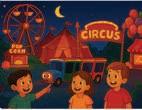
(e) The small red popcorn stall glows in the dark.
(f) The cute blue train is waiting at the entrance.
(g) Which boy is pointing at the colourful balloons?
2. Fill in the blanks with the correct possessive adjectives.
(a) Raju forgot to carry umbrella, so he got wet in the rain.
(b) Neha shared raincoat with her little sister.
(c) The children laughed as paper boats floated in the puddles.
(d) We wore gumboots and splashed in the muddy water.
(e) The frog jumped out of tiny home under the stone.
(f) ‘Can I use towel to dry myself?’ I asked my brother.

3. Read the short story below and fill in the blanks with the correct demonstrative adjectives.
(a) A boy saw an old lady waiting at the zebra crossing. He took her hand and said, ‘Let me help you cross (this / these / those) busy road safely.’
(b) The grandmother smiled and said, ‘Thank you, dear. Not enough children help others (these / this / those) days.’
(c) The boy smiled and said, ‘Let’s wait until (that / these) light turns red.’
(d) ‘Look at (those / that / this) cars! They’re going too fast,’ said the boy.
(e) The lady pointed at two school children helping a blind man. ‘I’m so happy to see (this / these / those) children caring for others.’

4. Read the passage. Fill in the blanks with the correct adjectives.
These many a few their packed kind distant
Some children find it difficult to go to school because they have to travel far.
(a) Some parents also have to travel to places for work.
(b) children want to go to school and learn new things.
(c) They walk for hours to get to school.
(d) The schools have buses and vans.
(quality) (demonstrative) (quantity) (quantity)
(e) They carry heavy bags and take food.
(f) Their teachers are and help them every day.
5. Rewrite the sentences correctly with the adjectives in the right order. Use the adjectives to describe the underlined nouns.
(a) hat old red farmer the wore an
(b) barn red big the near stood farmhouse the
(c) eggs some fresh collected we morning the in
(d) an rusty carried engine he shed the from old
(e) cows his large field two the in sat

6. Choose one of these space characters or draw your own. In your notebook, write a description of the character using at least FIVE adjectives. You can give your character a name. (possessive) (quality) (quality)
















Read the text given below.
It was the day of the Annual Science Fair. The school buzzed with excitement! Vaani, Sanyam and Meera were standing near their projects. Everyone had to show their volcano models.
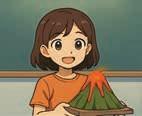
Vaani’s volcano was big and looked active. She gave a clear explanation.
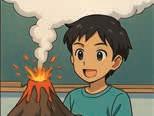
Sanyam’s volcano was bigger and even more active—it had black smoke coming out. When it was time to explain, his explanation was clearer than Vaani’s.
Think about and discuss these questions.
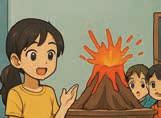
But Meera’s volcano was the biggest—it rumbled, hissed and made everyone step back in surprise! Hers was the most active. Meera was well prepared and her explanation was the clearest.
1. Whose volcano was big, whose was bigger and whose was the biggest?
2. How was Vaani’s explanation different from Sanyam’s and Meera’s?

When we use adjectives to compare people, places, animals or things, we use degrees of comparison.
There are three degrees of comparison:
1. Positive Degree – It shows the quality of one person or thing. For example: Vaani’s volcano was big. Vaani’s volcano was active.

2. Comparative Degree – It compares the quality describing two or more nouns. It is most often formed by adding -er to short adjectives, or using more before adjectives with two or more syllables. We show the comparison between two things with the use of the word than. For example: Sanyam’s volcano was bigger than Vaani’s. Sanyam’s volcano was more active than Vaani’s. (two syllables ac-tive)

3. Superlative Degree – It compares the quality of more than two people or things. It is most often formed by adding -est to short adjectives, or by using most before adjectives with two or more syllables. We add the before the superlative degree of the adjectives. For example: Meera’s volcano was the biggest of all. Meera’s volcano was the most active of all.
Rules for Forming Comparatives and Superlatives

For most singlesyllable adjectives
For adjectives ending with -e add -r add -st
For adjectives ending with a consonant + -y change -y to -ier change -y to -iest busy heavy busier heavier busiest heaviest
For one-syllable adjectives with a single vowel and a single consonant at the end double the last consonant and add -er double the last consonant and add -est big hot bigger hotter biggest hottest
For adjectives with more than two syllables dangerous intelligent use more before the adjective use most before the adjective more dangerous more intelligent most dangerous most intelligent
A few adjectives don’t follow these rules and change completely good bad little far better worse less farther/further best worst least farthest/furthest
A syllable is a single sound unit in a word. It usually has one vowel sound with or without surrounding consonants. For example: Tall has one syllable, whereas in-tel-li-gent has four syllables.


Look at the pictures. Choose the correct adjectives and write their positive, comparative and superlative forms. bright happy comfortable heavy
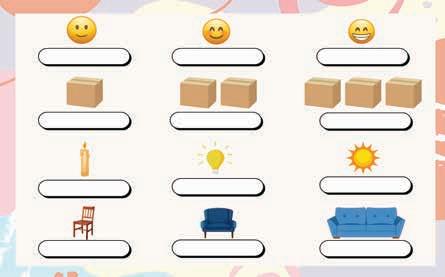

1. Circle the correct form of the adjective in the brackets.
One evening, Arjun and his friends visited the science museum. They were amazed by what they saw inside.
(a) The robot at the entrance was (smart / smarter) and looked almost real.
(b) The space rocket model was (taller / tallest) than the aeroplane model.
(c) The dinosaur skeleton was the (bigger / biggest) exhibit in the hall.
(d) The planetarium show was (interesting / more interesting) than the film.
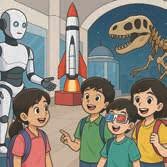
(e) The 3D glasses made the pictures (clearer / clearest) than before.
(f) For Arjun, the science trip was the (more exciting / most exciting) learning experience of the year.
2. Compare the objects by writing three sentences using the given adjectives in the positive, comparative and superlative form.
(a) Fast The car is The train is The aeroplane is

(b) Expensive

The ring is The necklace is The crown is
3. Some adjectives in the paragraph are incorrect. Rewrite the paragraph correctly and underline the adjectives you corrected.
One afternoon, Ajit and Neha went to the school library. Ajit said that the book he chose has the interestingest story he had ever read. Neha chose a book with pictures that looked colourfuler than Ajit’s. The thick history book was the boringest one on the shelf. The science encyclopaedia was easiest to understand than the maths book. Neha and Ajit agreed that the library was the goodest place to spend their free time.
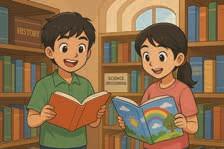









Read the story aloud.
A Mandala is a special kind of drawing made with circles, shapes and patterns. The Mandalas are bright and full of meaning. Jatin is very interested in Mandala art. He has a big box of colourful markers and pencils. Every evening, he draws beautiful designs on paper.
Today, Jatin is making a Mandala carefully at his desk. His friends are watching him. Last week, he painted one on a large chart for his school art show. His teacher helped him by giving ideas about colours. His friends were impressed because his Mandala was very neat. Last year, Jatin had a sketchbook filled with designs, but he gave it to a friend. He has a new book now. He will fill it with pretty designs.
Think about and discuss these questions.
1. Look at the verbs in red. Do they show actions or possession? Do they stand alone?
2. Look at the verbs in blue. Do they stand alone, or do they help a main verb in the sentences?
3. A big box of colourful markers and pencils belongs to Jatin. Which word shows this?

Every sentence needs a verb. A verb is the heart of a sentence. It tells us what someone is doing (action), what someone is or what someone has.
Main verbs stand alone and carry the tense of the sentence.
1. Action verbs – These are words that show actions. For example: Jatin draws/drew beautiful designs on paper.
2. Verbs ‘to be’ – These are words that show what someone or something is or feels – is, are, am, was, were. For example: Each picture is/was special to Jatin. Their paintings are/were neat.
1. Verbs tell us about the time of an action. This is called tense. I go I went I will go (present) (past) (future)
2. In the simple present tense: I, you, we, they – base form (go) He, she, it – base + -s or -es (goes)
3. Verbs that show belonging/possession – These are words that show something belongs to someone – has, have and had. For example: Jatin has/had a big box of colourful markers.
Helping verbs work with another verb to show the tense. These are: is, are, am, was, were, has, have, had, will, etc.
For example: Jatin is making a Mandala carefully at his desk. (is helps the main verb making) His friends are watching him. (are helps the main verb watching)
Jatin will fill his sketchbook with pretty designs. (will helps to show that the action (fill) will happen in the future)


1. Play in a group of 8. Take turns to be a detective.
2. Detective work: The detective of the group underlines the verb/s in the sentence and reads the sentence aloud. He/She says if the sentence has a main verb or both a helping and a main verb.
We know that helping verbs are like friends that help the main verb show the tense of a sentence. Do, does and did are also helping verbs.
For example: Does Jatin draw beautiful designs on cardboard?
No, he doesn’t. He draws on paper.

Materials needed:
• Slips of paper with sentences (One set per group)
• Markers or pens
• Two baskets or bowls (labelled Main Verbs or Helping Verbs and Main Verbs )
• A small detective hat or magnifying glass (optional, just for fun!)
3. Checking and sorting: Group members check if the detective is correct and if he/she puts the slip in the correct basket—Main Verbs or Helping Verbs and Main Verbs.
4. Scoring: If the detective gets the answer right, he/she scores one mark.

Write these sentences on chits and hand out a set of 8 sentence slips to each group: A detective is a problem solver. Detectives have sharp minds. The detective identified the thief. The detectives were in a meeting. The detective was following the thief. In future, the detectives will follow the clues. The detective is taking fingerprints. The detective solved the case.


1. Underline the verbs in each sentence. Then, write their type (Action, Being or Belonging).
(a) The children play cricket together every weekend.
(b) We invite all our friends to the park.
(c) Anush has an extra bat to share.
(d) I am happy when everyone joins the game.
(e) Santosh is kind to new players.

2. Look at each sentence. Add -s, -es where necessary so that the verbs match the subjects.
(a) My friends, my brother and I (work) on an art project together.
(b) My friends (cut) the newspapers into strips.
(c) My brother (mix) glue with water.
(d) Avni (put) glue on the strips.
(e) Abhishek and Sneha (roll) the paper strips.
(f) Manish (dry) the paper rolls.
(g) The children (weave) objects with the strips.
3. Underline the correct verb in each sentence.
(a) The hockey player (was / were / had) very skilled.
(b) We (is / am / are) excited about the match.
(c) She (is / has / have) a new hockey stick.

(d) The coaches (is / are / have) very proud.
(e) She (was / were / had) the best defence strategy in the team.

4. Use the clues in the box and fill in the correct form of the verbs in the blanks. You may have to change the form. Some verbs can be used twice.
run sow is water help work plant shine have are
Farming (a) an important job in many countries.
Farmers (b) hard every day. They (c)
seeds in the soil and (d) the saplings carefully. The sun
(e) brightly at the moment. Tomorrow, the farmers (f) their fields so that the plants do not dry out. Farmers
(g) many tools to help them. Some farmers (h) tired.
The animals on the farm (i) fresh food and clean water. Everyone (j) with the chores to make sure the farm (k) smoothly.
5. Choose a job from the present time (lawyer, secretary, nurse, pilot, etc.) or a job that people did in the past (hunter, blacksmith, healer, lift operator, etc.) Read up about the job and present a speech about it.
• Say what the person does/did.
• How the job helps/helped others.
• Why you would like or would have liked to do this job.
W hen planning your speech, use at least two action verbs, two ‘to be’ verbs and two verbs that show belonging.








Look at the picture. Complete the text with the words that describe what you see.
The learners are sitting . (inside / there / here)
The teacher is explaining . (kindly / calmly / clearly / patiently)
The girl in the yellow T-shirt is writing . (slowly / quietly / carefully / thoughtfully)
The girl in the blue T-shirt (seldom / often / usually) puts up her hand.
Think about and discuss these questions.
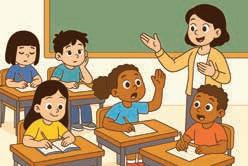
1. Circle the words in the sentences that the words in the brackets are describing.
2. Are the words you circled nouns or verbs?

Words like kindly, calmly, neatly, slowly, inside, often, seldom and patiently tell us more about the verbs and are called adverbs.
There are four types of adverbs:
Adverbs that tell us how actions are done are called adverbs of manner. They answer the question how.
For example: The girl answers quickly. (How?)
The children are studying quietly. (How?)
Adverbs of manner mostly end in -ly.
Here are some more adverbs of manner: honestly happily lazily smartly softly silently angrily
Adverbs that tell us when an action happens are called adverbs of time. They answer the question when.
For example: I wake up early for school. (When?)
I wrote an essay yesterday (When?)
Here are some more adverbs of time: early yesterday soon now today then

Adverbs that tell us how often an action happens are called adverbs of frequency. They answer the question how often.
For example: It rains daily in the monsoon. (How often?)
This girl always wins the game. (How often?)
Here are some more adverbs of frequency: weekly usually often sometimes hardly seldom never
Adverbs that tell us where an action takes place are called adverbs of place. They answer the question where.
For example: The children are playing outside. (Where?)
The boy is sitting there. (Where?)
Here are some more adverbs of place: there here up out down above below in
Note: Adverbs of place stand alone and do not need an object. On the other hand, prepositions are always followed by nouns.
For example: Is your father in? (Adverb) The children are in the classroom. (Preposition)


Solve the crossword by filling in adverbs that match the clues. angrily calmly loudly early quickly slowly seldom above
Across
1. The kite is flying high .
2. She finished her homework not late.
3. He ran to catch the bus.
4. The turtle moves across the road.
Down
1. The dog barked at the stranger.
2. She shouted during the game.
3. They eat out.
4. He answered the question , not in a hurry.

1. Underline the adverbs in each sentence and circle whether it tells how, when, how often or where. One has been done for you.
(a) The children are practising a skit for school tomorrow. (how / when / where)
(b) They are practising outside. (how / when / where)
(c) They rarely miss their practice. (how / when / how often)
(d) Kaaya and Ishita clap enthusiastically. (how / when / where)
(e) Raman plays and sings loudly. (how / when / where)
(f) They must finalise the skit today. (how / when / where)
2. Fill in the blanks with suitable adverbs.
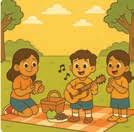
(a) The children are walking in the zoo. (manner)
(b) It is good that the lion is not . (place)
(c) The children visit the zoo . (frequency)
(d) There are birds flying . (place)
(e) The zoo will close . (time)

(f) The children will come to the zoo again . (time)
3. Complete the character sketch by choosing words from the box. seriously patiently outside quickly often
Hermione Granger, one of the main characters in Harry Potter, is a clever and responsible student at Hogwarts. We know this because she (a) helps Harry and Ron with their homework and explains everything to them (b) . She enjoys reading and rarely spends time (c) . She has risen to the top of her class (d) and takes her studies (e) .








Anna and her mother are visiting Delhi for the first time. Read the conversation.
Mother: That baker y has been in Delhi since 1926!
Anna: The guidebook says it has been in this street for nearly a century.
Mother: Let’s go across the street and see what they have on those shelves.
Anna: The woman coming towards us has bought a big cake.
Think about and discuss these questions.
1. What does in tell us in ‘The bakery is in Delhi’?
2. What does since 1926 show?
3. What does for nearly a century show—time or place?
4. Which words show movement?


A preposition connects the noun or pronoun with another word in a sentence. Prepositions are important because they tell us where, when or how something happens. Without them, sentences may not be clear.
Look at how these prepositions tell us when something happens.
In
Used with months, years and parts of the day
The bakery opened in 1926.
I went to the bakery in the morning/evening.
On
Used with days and dates
The bakery is closed on Sundays.
At
Used with exact clock time and with night
The bakery opens at 8 o’clock. It is not open at night.
From...to...
Used to tell the length of time
Before
Used to show that something happens/ happened earlier I visit the bakery before school every day.
After
Used to show a later time I visit the bakery after school.
Since
Used to show a period starting in the past and usually carrying on until now The bakery has been open since 1926.
The bakery is closed from 10 o’clock to 4 o’clock. The bakery is open from Monday to Friday. For
Used to show length of time I sat in the bakery for three hours.
Prepositions of place tell us where something is.
In
To show something inside a space
There are many people in the bakery.
At
For an exact place or point
The owner is standing at the door.
Over/Above
To show a higher position
The owner lives above the bakery. The baker has used cling wrap over the cookies.
Near
Close but not touching or immediately beside
The bakery is near my house.
To show something on a surface There are pastries on the shelf.
To show a lower position or underneath The donuts are under the cream cakes on the shelf. The parking lot is below the bakery.
Between
To show something in the middle of two things The bakery is between a bank and a chemist.
In front of
To show something ahead of another The customers are standing in front of the counter.
Next to
Immediately beside or touching another thing
The bakery is next to the bank.
Behind
To show something at the back
The police station is behind the bakery.
Immediately next to or touching another thing It is more formal than ‘next to’.
The bakery is beside the bank.
Among
To show that something or someone is in the middle of, or included in, a group
The cupcake I wanted was the tastiest among all the others.
Note: In versus Into He is in the garden. (He is not moving.) He ran into the garden. (He went there. It shows movement.)
Prepositions of movement show us the direction in which something is moving.
Into
To show movement towards the inside of something
The baker was putting the pastries into the box.
To
To show movement towards a place or a destination
She is going to the bakery.
To show the starting point of movement
The train leaves from Delhi.
Onto
To show movement to the top of something
The cat climbed onto the roof.
Over
To show movement across the top of something
The plane flew over the city.
Towards
To show movement in the direction of something
The boy is walking towards the bakery.
Through
To show movement from one side to the other side by going inside or within
The man rode through the underpass to deliver the cake.
Across
To show movement from one side to the other side
The children ran across the road.
Along
To show movement following the length of something
They walked along the river.
Around
To show movement in a circular path
The earth moves around the sun.

Beside → tells position (place)
Besides → adds information (extra person/thing)

Wrong: I sat besides my brother. Correct: I sat beside my brother.

Form a team of four. Look at the image given below. Each team needs to make at least eight sentences using prepositions. The first team to get all correct wins.
The lamp is on the table.
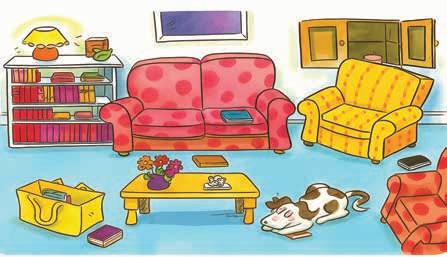

1. Look at the image and fill in the blanks using the correct prepositions.
(a) There is a roof the house. (on / in / at)
(b) The cars are parked the garage. (in / on / under)
(c) The letterbox is the path. (next to / under / behind)




(d) The window is the balcony. (above / on / under)
(e) The door is one end of the path. (at / behind / in)
2. David wants to share his day with all of you. Fill in the blanks with the prepositions in the box. You may use a preposition more than once. at on from behind in under near to
I wake up (a) 6:30 a.m. in the morning. I get ready and eat my breakfast.
My school is (b) 8 a.m. (c) 2 p.m. (d)
lunchtime, I usually eat with my best friends (e) the tree. Our classroom is (f) the second floor of the school building. My seat is (g) the last row, (h) the notice board. My best friend sits (i) me. Our class library is (j) the corner.

3. In your notebook, rewrite the paragraph with the correct prepositions. next to in front of on over under above onto


Last Sunday, we visited Qutb Minar. First, we walked onto the small bridge near the entrance. The tall tower stood high over us, looking grand and beautiful. I climbed in the steps to get a better view. My father asked me to stand behind the tower so that he could take a photo. A dog was resting into a tree nearby. There were many tourists sitting between the benches and some standing across the ticket counter, waiting for their turn.
4. In your notebook, write a short description of a place in your neighbourhood. Use and label the prepositions of time (T), place (P) and movement (M).
For example: There is a small park near (P) my house. Children play in (P) the park in (T) the evening. To enter the park, you walk through (M) the big gate. There is a fountain in (P) the middle of the park. Children run around (M) it. Families often visit the park on (T) Sundays.
Time: 40 mins
Total: 25 Marks
1. Fill in the blanks with the correct adjectives. (6 × ½ = 3 marks) their small large this many his
(a) Some coaches work in gyms to train their athletes.
(b) Athletes practise for hours to build their strength.
(c) Athletes must keep water bottles with them.
(d) rule is important because their bodies need water.
(e) One athlete has to fill bottle regularly because it is so .
2. Rewrite the sentences putting the words in brackets in the correct order. (1 × 2 = 2 marks)
(a) Those (men, tall, young) are good athletes.
(b) The athletes use (jute, strong, ropes) to build their strength.
3. Fill in the blanks with the correct comparative or superlative adjectives. (5 × 1 = 5 marks)
(a) Kajari is the (famous) monsoon dance in Bihar and Uttar Pradesh.
(b) Kathak is (graceful) dance than Kajari.
(c) Kajari music is (soft) than some other dance music.
(d) Out of all the dances, Nautanki has the (loud) music.
(e) Kajari is more peaceful than Karma, which has (fast) movements. (quality) (quantity) (possessive) (demonstrative) (possessive) (quality)
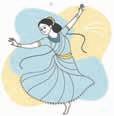
4. Choose the correct form of the verbs to complete the text. (10 × ½ = 5 marks)
Shiva is my next-door neighbour. He and his father (a) (has / have) new dhotis. Shiva’s dhoti (b) (has / have) a pretty golden border. He (c) (watch / watches) his father folding and tying his dhoti, but Shiva (d) (are struggling / is struggling) with his own. His mother (e) (helps / help) him. They (f) (stands / stand) in front of the mirror so that Shiva can see what his mother (g) (is doing / doing). When everyone (h) (is / are) dressed, they stand outside and I (i) (take / takes) a photo of them. They all (j) (looks / look) very smart.

5. Fill in the blanks with the correct prepositions. (5 × 1 = 5 marks)
(a) The children played the park after school.
(b) There were pretty flowers and small bushes the tree trunks.
(c) Nisha put her hands her eyes so that the others could hide.
(d) The other children hid the big trees.
(e) The fruit sellers were standing the street.
6. Write a paragraph of 50–60 words to describe the Independence Day celebration at your school. Use at least FIVE adjectives to describe the event. Underline the adjectives you have used. Remember that adjectives tell you more about nouns. (5 marks) colourful delicious tricolour tasty graceful melodious eventful proud









Read the conversation between Raj and Sameer.
Raj: I want to play basketball, but it’s raining outside.
Sameer: We can play inside because I brought a soft ball.
Raj: We can practise our passes and how to score.
Sameer: We can try that although we don’t have much space.
Raj: I think we should wait until the rain stops.
Sameer: We will run to the park when it stops.
Raj: I hope that it stops soon.
After some time...
Sameer: Look outside! I think it has stopped, so we can go out.
Think about and discuss these questions.
1. Which two sentences have been joined in the first line that Raj speaks? Which word has been used to join the two sentences?
2. Which sentences have been joined in the last line? Which word has been used to join them?
3. Are these complete sentences (can stand on their own)?
• Because I brought a soft ball • Until the rain stops • That it stops soon

The words but, and, so, because, although, until, when and that are conjunctions.
Conjunctions connect words, groups of words or sentences. They help to join ideas so that the sentences make sense.
• joins similar words or group of words
• adds one idea to another
Raj and Sameer want to play basketball. We can practise our passes and how to score. but
• shows two opposite ideas or contrast I want to play basketball, but it is raining. so
• shows what happened because of something or as a result of something
The rain has stopped, so we can go out. because
• gives a reason behind something
We stayed indoors because it was raining. when
• tells us the time something happens
We will run to the park when it stops raining. until
• shows one thing continues up to the time something else happens
We will have to wait until the rain stops. although
• shows contrast (like but)
We can play indoors although we don’t have much space. that
• to give reasons or explanations
• to report speech, thoughts or feelings
T hink and Tell
Is that a conjunction in the given sentence?
(Does it connect ideas or does it tell you more about the noun?)
That grass is green.

What you need: A soft ball
I hope that it stops soon. She said that she was tired.
Note: Use a comma before but, so and and when joining two full sentences.
For example: I wanted to read, but my book was missing.

I brought my umbrella…
How to play: • The teacher says a sentence starter and throws the ball to a student.
• The student catches the ball and finishes the sentence using a conjunction. He/She tosses the ball back.
…because it looked as if it would rain.
Write these conjunctions on the board: and, but, so, because, when, until, although, that Teacher Tip!


1. Underline the words that join ideas in the sentences.
One afternoon, we decided to experiment with different paint colours.
(a) I wanted to use yellow, but I did not have any.
(b) The colours blended nicely, so I took a picture.
(c) I added more water because the paint was too thick.
(d) Our paintings dried quickly when we left them in the sun.
(e) The paintings looked good although we used many different colours.

2. Tick ( ) the correct conjunctions.
(a) Sangam kicked the ball, scored a goal. (and / until)
(b) Arpit and Simran stayed on the field the coach blew the whistle. (but / until)
(c) Amisha aimed carefully, she missed the goal. (but / because)
(d) Tauheed dived, he could catch the ball. (so / although)
(e) The team celebrated they had won the match. (because / although)

3. Circle the correct conjunction in each sentence.
(a) Sneha mixed the red liquid (and / until) the blue liquid to see what would happen.
(b) Chandani wore safety goggles (because / although) the teacher told her to.
(c) Anuj poured the liquid carefully, (so / but) he didn’t spill any.
(d) Kashika got a fright (when / until) the liquid started bubbling.
(e) Abhishek learnt (that / and) heat can make ice melt faster.

4. Join the sentences using the correct conjunctions—and, but, so, because, when, until, although, that.
(a) Rakesh has practised a lot. He is still nervous about speaking
(b) Bhavna takes deep breaths. It helps her relax.
(c) Vishesh and I will practise together. I am sure we will do well in the competition.
(d) You should wait quietly. The teacher will call your name soon.
(e) Ayushi is scared. She knows she has practised enough.

5. What should you do if you are in a building and the fire alarm goes off? Write five rules you must follow to stay safe. Use a conjunction in each sentence.


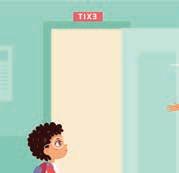


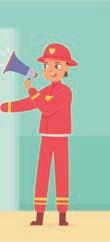









Read the conversation below.
The teacher gives a quick maths riddle: I am a two-digit number. My tens digit is 4. The sum of my digits is 9. What am I? As the group works out the answer, the children react.
Oh yes! I got the answer!
Hmm, I was still thinking about it. Really? Can you help me solve it too? Wow! You solved it so quickly!
Think about and discuss these questions.
1. Which words in the children’s comments show feelings?
2. What feeling does each word show?
3. Which interjection would you use when the teacher says you are the only one who got the answer right? What feeling does the word show?
4. Complete the sentence, starting with an interjection: ‘ ! We solved it.’
The words ‘Oh yes!’ and ‘ Wow!’ express emotions. They are called interjections.


Interjections are words that help us express emotions.
For example: Hurray! I won the game. (happiness)
Hey! Be careful. (attention grabber)
Oh no! I lost my book. (sadness)
Umm, I am not sure. (hesitation, uncertainty)
Aha, I understand. (realisation)
Interjections are often followed by an exclamation mark (!) They can also be followed by a comma (,) or a question mark (?) based on the emotion being expressed.
For example: Hmm, I think the answer is 45. (thinking)
Really? You made it! (disbelief)
Wow, that’s interesting.
Remember!
When an interjection stands alone and has an exclamation mark (!), the next sentence starts with a capital letter. For example: Wow! That painting is brilliant. Oh no! We spilt the paint.
Let us look at some common interjections and the emotions they express.
Interjection
Emotion Expressed
Hurray! Wow! Bravo! Yay! Great! joy/happiness
Aha! Oh! realisation
Ouch! Ow! pain
Oh! What! Whoa! surprise/shock
Yuck! Eww! Ugh! disgust/dislike
Alas! Oh no! Oops! sadness/regret
Hey! Look! Listen! urgency/attention grabber
Hmm, Err, Mmm thought/hesitation
What? Eh? Huh? Really? confusion/uncertainty
Phew! Ah!

1. Divide the class into two teams (A and B).
2. Prepare chits with interjections: Wow! Ouch! Yuck! Oh no! Hurray! Hey! Alas! etc.








3. One student from Team A picks up a chit and acts out the feeling. (without saying the word)
4. Team B has 30 seconds to guess the interjection.
5. If Team B guesses correctly, they must say a complete sentence using that interjection
For example: Oops, I dropped my ruler.
6. A team earns a point for a correct guess and another point for a sentence that matches the feeling.
7. Team B gets a turn to pick up a chit and Team A guesses the word. Play 5 or 6 rounds. The team with the most points wins.

1. Fill in the blanks with suitable interjections. Wow! Yuck Oh no! Hurray! Oops!
(a) I won the painting competition.
(b) I lost my crayons.
(c) What a beautiful painting!
(d) I spilt the paint.
(e) , the paint smells terrible!

2. Choose the correct interjections and fill in the blanks. The children are talking at lunch time.
(a) I packed fruit and nuts instead of chips. (Ouch! / Look! / Oh!)
(b) That fresh carrot juice looks so tasty. (Ew! / Wow! / Alas!)
(c) I forgot to bring my water bottle. (Hurray! / Oh no! / Wow!)
(d) I ate too fast and now I have a tummy ache. (Ouch! / Oh! / Look!)
3. Fill in each blank with a suitable interjection. Use the correct punctuation.
(a) Aanya: I think our food-stall idea is brilliant.
(b) Kabir: I love food. India has so many dishes.
(c) Aanya: We can add idli with sambar from the South.
Kabir: that is light and healthy.
(d) Aanya: From Punjab, we can add chole bhature.
Kabir: That’s spicy and fluffy.
(e) Aanya: Gujarat has soft dhokla and crispy khakhra.
Kabir: Can we add a sweet from Bengal, like rasgulla?
(f) Aanya: Good idea. From Kashmir we could include rogan josh.
Kabir: Our menu is turning into a food tour of India!
Let’s make a poster that says, ‘Many States, Many Tastes’.

4. Imagine that you are giving a sports commentary on an exciting match. Give a short commentary in class. Use at least four interjections. First, write your commentary. Then, present it in class.









Read what Aditi and Krish are up to.
Aditi: Krish, can you come to the cricket field after school?
Krish: I’ll ask if I may come. I must finish my homework first.
Aditi: You should do it quickly.
Krish: Okay, but it might rain later.
Aditi: If it rains, we can play basketball in the indoor court.
Krish: We could also play in our society’s club house.
Think about and discuss these questions.
1. Which word shows that Aditi is asking if something is possible? (must / can / should)
2. Which sentence shows that Krish has to do his homework first?
3. Which word shows that Aditi is giving advice to Krish? (can / should / might)
4. Which sentence shows that the weather may change later?

Modals are helping verbs that show possibility, ability, necessity, permission, advice, etc. They always come before the verbs and are followed by the base form of the verbs.
For example: She can bat very well. (modal) (base form of the verb)
Let us look at some modals.
Modals Uses Examples
must express strong necessity –something that has to be done
canshow ability
ask and give permission (informal) express possibility
could show past ability make a polite request/ask permission express a possibility
shouldgive advice show duty/express responsibility make a suggestion
mayask and give permission (formal) express possibility express a wish
I must finish my homework.
I can play cricket. Can I go and play cricket? Yes, you can. Can we play cricket today?
I could play cricket when I was young. Could we play again, sir?
We could go, but I am not sure.
You should hold the bat like this. You should apologise for being late.
You should try this fun game.
May we please use the ball, ma’am? It may rain today.
May you achieve success mightshow a small possibility (less certain than may) It might rain in the evening, but I doubt it.
Note: Can is used to ask for permission in an informal way. Could and may are more formal and polite. For example: Can I go, mom? Yes, you can. May I have your autograph, sir?
Could I have your autograph, please?
• To form a negative sentence with a modal, use the modal followed by not. can – cannot/can’t should – should not/shouldn’t must – must not/mustn’t could – could not/couldn’t may – may not might – might not
• To form a question, use the modals followed by the subject of the sentence. You can add a question word.
I can play cricket I cannot/can’t play cricket Can I play cricket?
I should bat first. I should not/shouldn’t bat first. Why should I bat first? Should I bat first?

Fill in the sentences and colour the boxes.
• Colour in the boxes that use can/can’t in green.
• Colour in the boxes that use should/shouldn’t in orange.
• Colour in the boxes that use must in blue

Birds fly.
You turn off the light when leaving a room.

You throw waste in the bin.
Children not tease the monkeys . You cross on the zebra crossing.
Rohan lift heavy boxes.
1. Fill in the blanks with the correct modals.
(a) We carry an umbrella when it rains. (can / should)
(b) The road is slippery. You walk carefully. (must / may)
(c) There are dark clouds. It rain in the evening. (may / should)
(d) I borrow your raincoat, please? (May / Must)
(e) When I was younger, I jump over puddles easily. (could / should)
(f) Ma’am, don’t you think you declare a holiday tomorrow if there is a flood? (should / can) (advice) (necessity) (possibility) (request) (past ability) (suggestion)
2. Use modals from the box to complete the coach’s instructions. might should may must can
You (a) keep your stick low while dribbling! It’s hot. You (b) take a water break now. Be careful! You (c) trip if you don’t watch your step. You (d) easily score now if you aim well! If you do not run faster, you (e) not catch up later.

3. Read the conversation and fill in the blanks with the correct modals from the box. You may use an option twice. must should shouldn’t may May can’t can
The teacher is showing the class how to fold a paper dragon.
Teacher: You (a) choose any colour you like.
Mansi: Ma’am, my paper is very small, (b) I use it, or not?
Teacher: You (c) use it if you want, but the dragon will be tiny. Arjun, you (d) be so rough, otherwise, the paper will rip.
Reshma: This is tricky! I (e) do it.
Teacher: Don’t worry. It (f) look hard, but with practice, you will get it.
Riya: Oh, I think I got the wings right!
Teacher: Great! You (g) press the folds neatly, so the dragon (h) stand.








Read the comic.
Hello! I am the most important! Without me, no one knows who or what the sentence is about!

Think about and discuss these questions.
Stop arguing! You are a team. You both are important for a sentence.
That’s not true! Without me, no one knows what happens in the sentence!
1. Who tells us who or what the sentence is about?
2. Who tells us what happens in the sentence?
3. Can a sentence be complete without a subject or a predicate?


A sentence has two parts: a subject (naming part) and a predicate (doing part).
The subject is the part of the sentence that tells us who or what the sentence is about.
For example:
The predicate is the part of the sentence that tells us what the subject does or is. It tells us more about the subject.
The predicate must have a verb and usually starts with a verb.
Subject Predicate
Mr Subject talks about his importance.
Ms Predicate replies to Mr Subject. You can work together.
A predicate can have an object.
Every sentence has a predicate, but only some sentences have an object, depending on whether the verb needs something to act on.
For example:
SubjectPredicate
I/They made the cookie. Made what? the cookie Made is a verb that needs an object.
The cookiewas decorated by me. By whom? by me Decorated is a verb that needs an object.

1. Your teacher chooses one student to start the game.
2. The first Superhero gives a subject. For example: The little bird…


3. The next student adds a predicate to make a complete sentence. For example: ‘...flies in the sky’ The sentence becomes: ‘The little bird flies in the sky.’
4. The student who added the predicate becomes the new Superhero and starts with a new subject. Keep playing until everyone has had a turn!


1. Match the subjects in column A and the predicates in column B.
Column A
(a) India •
(b) Chess •
(c) Many tigers •

Column B
• i. was first played in India.
• ii. is called the ‘land of spices’.
• iii. is a colourful Indian festival.
(d) The Indian flag • • iv. are found in India.
(e) Holi • • v. has three colours.
2. Underline the subjects, verbs and objects in the sentences. One has been done for you.
(a) Ashoka built pillars.
(b) The pillars spread messages of peace.
(c) Craftsmen carved animals on the pillars.
(d) The inscriptions teach kindness and truth.
(e) People read the writings on the pillars.


3. Read the dialogue. Separate the subject and the predicate of each sentence and write them in two columns in your notebook.
Raavi: My friend Aman wants to play cricket for India.
Mother: That is wonderful!
Raavi: He wants to be like Jasprit Bumrah.
Mother: Jasprit is an excellent bowler!
Raavi: He is Aman’s hero.
Subject

Predicate
4. In your notebook, write FIVE sentences about a place in India that you have visited. Circle the subjects and underline the predicates in your sentences.








Aarav and Shivam are planning a picnic. Read their conversation.
Aarav: Yippee! I’m so excited about our picnic today.
Shivam: Me too! Do you know what time we are leaving?
Aarav: Yes, we are leaving at 10 o’clock.
Shivam: Great! Don’t forget to bring sandwiches and juice.
Aarav: Oh no, I almost forgot the juice!
Shivam: Are we also taking some games to play?
Aarav: Of course! I packed a football and a frisbee.
Shivam: Don’t be late! You overslept last year.
Think about and discuss these questions.
1. Shivam asks a question. Which punctuation mark is used to end the sentence?
2. Which punctuation mark is used to show Aarav’s excitement about the picnic?
Statements tell, questions ask and exclamations show strong feelings.
3. Underline the part where Shivam gives advice to Aarav (he reminds him of something).

Let us learn how sentences can be grouped into kinds.
A sentence is a group of words that makes complete sense. It should always have a clear meaning.
Declarative
Interrogative
Sentences
Exclamatory
• These are statements that tell us something or give information.
• They end with a full stop.
• I am excited about our picnic day.
• We are leaving at 10 o’clock.
• These sentences ask questions.
• They end with a question mark.
• Are we also taking some games to play?
• When are we leaving for the picnic?
• These sentences show strong feelings like surprise, excitement, anger or joy.
• The exclamation mark comes either at the end of the sentence or after the exclamatory word.
• Oh no, I almost forgot the juice!
• Yippee! It’s our picnic day.
• They are commands, requests, instructions, warnings or advice.
Imperative
• They usually end with a full stop but can also have an exclamation mark, if the idea needs to be emphasised (stressed).
• Don’t forget to bring sandwiches and juice. (advice)
• Stop shouting! (command)
• Call my mother, please. (request)
• Don’t do that! (warning)
• Close the door quietly. (instruction)

What you need:
• An empty bottle
• A chart with a large circle divided into four sections as shown.
How to play:
1. Place the bottle in the middle of the circle.
Note: ‘You’ (who is being addressed) is usually not mentioned.

2. Take turns to spin the bottle.

3. When the bottle stops, look at the section where the opening points.
4. Say or write a declarative, exclamatory, interrogative or imperative sentence, depending on the section.
5. Your teacher may also give you a topic, such as animals, sports, geography, art, science or maths

1. Match the sentences and the type.

Tom chases Jerry around the kitchen. • • Exclamatory

Did Scooby-Doo find the ghost? • • Imperative

Please give SpongeBob the jellyfish net. • • Interrogative

Wow! The music makes me want to dance. • • Declarative

2. Read each sentence and write whether it is Declarative (D), Interrogative (Q), Imperative (I) or Exclamatory (E).
(a) Finish your food.
(b) How can we store leftover food safely?
(c) Pack only the lunch you can eat.
(d) What a delicious way to use extra bread!
(e) Our school started a compost bin for food scraps.
(f) Don’t throw away that apple!
(g) Why is it important not to waste food?
(h) We keep apples in the fridge, so they last longer.

3. Read each sentence and circle the correct punctuation mark.
(a) I feel happy when I go on the rides with my friends ( . ? ! )
(b) Stop screaming on the roller coaster ( . ? ! )
(c) Why does the giant wheel scare you so much ( . ? ! )
(d) Wow, I can’t believe we are eating ice cream at the amusement park ( . ? ! )
(e) Do you feel excited before going on the roller coaster ( . ? ! )

4. Read each sentence and rewrite it as the type given in brackets.
(a) We are making puppets in art class. (Change to interrogative)

(b) Can you pass me the glue? (Change to declarative)
(c) The puppet’s clothes are colourful. (Change to exclamatory)
(d) Can you put away the paint brushes? (Change to imperative)
5. Write a conversation between two children who are playing basketball. Use all four types of sentences.
Time: 40 mins
Total: 25 Marks
1. Fill in the blanks with the correct conjunctions (but, and, so, because, although, until, when, that). (5 × 1 = 5 marks)
(a) I wanted a role in the Ramayana play, the organisers said that I was too young.
(b) We ate puri, sabzi jalebi on Dussehra.
(c) The roads were crowded everyone was going to see the Durga Puja pandals.
(d) I will not visit the pandals my parents give me permission to go.
(e) Rahul was happy he won many gifts at the mela.
2. Read the sentences based on daily habits. Fill in the blanks with the correct modals. (5 × 1 = 5 marks)
(a) You wash your hands before eating. (must / might)
(b) We brush our teeth twice a day to keep them healthy. (should / may)
(c) You use either your hands or a spoon to eat rice dishes. (must / can)

(d) You forget some of your books if you don’t pack your school bag in the evening. (can / may)
(e) You take your water bottle to school every day. (could / must)
3. Kriti visits the new mall in her town. Read the sentences and fill in the blanks with the correct interjections. (5 × 1 = 5 marks)
(a) I found a toy shop with robots that can actually talk.
(b) , the chocolate fountain looks incredible!
(c) The food court is so crowded, and my favourite jar cake is sold out.
(d) There is a gaming zone with so many fun rides and games.
(e) I got a surprise voucher with my purchase.
4. Answer these questions on subject and predicate. (5 × 1 = 5 marks)
(a) Circle the subject and underline the predicate.
i. Rajendra Prasad was the first President of India.
ii. People respected Rajendra Prasad for his honesty.
(b) Look at the picture. Write THREE sentences. Circle the subject and underline the predicate.

5. Fill in the blanks to complete the conversation between Yuvraj and Ali. Use all four types of sentences (Interrogative, Declarative, Imperative, Exclamatory). (5 × 1 = 5 marks)
Yuvraj: Hi Ali, (a) your preparations going for the exams? (Interrogative)
Ali: I am revising my lessons. I feel ready for the exams.
Yuvraj: That’s good. Can you share your maths notes with me?
Ali: Yes, (b) . (Declarative)
Yuvraj: Thank you. I find maths a bit difficult.
Ali: (c) Come . (Imperative)
Yuvraj: (d) at 3 o’clock? (Interrogative)
Ali: Yes, that sounds fine.
Yuvraj: (e) Thank you. ! (Exclamatory)








Read the conversation between Rohan and Neha.
Hi Rohan. Is your homework done?
The English homework is easy. Do you need any help? Did you check the notes the teacher gave us?
Think about and discuss these questions.
1. Which sentences in the conversation are questions?
2. Which words do these questions start with?
No, it isn’t. I must still finish my science and English. I am good at English, so it’s fine. Yesterday, I didn’t finish my science work. I must do it today. No, I didn’t. I think I left them at school.
3. Which sentences include the word not, or a shortened form of not?
4. Why do we use not in some sentences?

In sentences with the verbs is, are, am, was or were, we form questions by changing the order of the subject and the verb and adding a question mark.
Questions usually begin with verbs like is, am, are, was, were, do, does or did. We can also add question words like what, where, when, why and how.
For example: Your homework is done. Is your homework done? subject verb ( The verb moves to the beginning.)
In sentences that have only an action verb like in the simple present and the simple past tenses, we add the helping verbs do, does and did.
Neha finishes her homework every day. Does Neha finish her homework every day? They complete their homework. Do they complete their homework?
I checked the teacher’s notes yesterday. Did I check the teacher’s notes?
Forming Questions Using Modals
I must finish my homework. Must I finish my homework?
Note: Do, did and does are super helping verbs that take on the tense in the question. The verb that follows is in the base form.
A negative is a sentence that says something is not true or did not happen. To form a negative, we add not after the verb.
Note: An affirmative sentence says something that is true and has happened. For example: I have finishshed all my homework
Sentences with is, are, am, was or were
Sentences with modalsSentences with action verbs add not
modal + not + base form of the verb Add do, does, did + not + base form of the action verb
I am not ready. Neha is not/isn’t helpful. My notes were not/ weren’t lost.
I must not/mustn’t act lazy. I cannot/can’t do my work. I may not do my homework.
Rohan doesn’t finish his work. He doesn’t do his homework. He didn't do his homework.
How will you use these question words to form the questions? Do the rules for forming questions change when using a question word?
1. Neha finishes her homework in time. Who…? 2. Neha offers to help Rohan with English. Does…?
3. Rohan left his notes at school. Where…? 4. The English homework was easy. Which…?




Sing the song to learn the rules.
If you’re telling me a fact, it’s a statement. (clap, clap)
If you’re telling me a fact, it’s a statement. (clap, clap) It ends with a dot, It says what something’s got.
If you’re telling me a fact, it’s a statement. (clap, clap)
When you ask, the verb and subject change around. (clap, clap)
When you ask, the verb and subject change around. (clap, clap)
You use a question mark, And an answer you will spark.
When you ask, the verb and subject change around. (clap, clap)
If something is not true, add a not. (clap, clap)
If something is not true, add a not. (clap, clap)
If the helper takes the tense, Use the base form to make sense.
If something is not true, add a not. (clap, clap)

1. Identify the sentence type. Underline A for Affirmative statements, Q for Questions and N for Negative statements.
(a) Does Kerala have a long coastline? ( A / Q / N )
(b) Rajasthan has many beautiful forts. ( A / Q / N )
(c) I didn’t visit Punjab last year. ( A / Q / N )
(d) Assam is famous for its tea gardens. ( A / Q / N )
(e) Did you go to Goa in December? ( A / Q / N )
(f) Gujarat is known for the Gir National Park. ( A / Q / N )

2. Fill in the blanks with the correct words.
(a) you play basketball after school? (Do / Does)
(b) you win the match yesterday? (Do / Did)
(c) Luckily, I forget my basketball shoes at home again. (don’t / didn’t)
(d) Amrit like playing on the grass court. (don’t / doesn’t)
(e) your friends enjoy watching the basketball match yesterday? (Did / Does)

3. A class is having a discussion on reducing plastic waste. In your notebook, change the following statements into questions.
(a) We use paper bags for shopping.
(b) She carries a reusable water bottle.
(c) They recycled plastic bottles.
(d) Our school has a campaign to reduce plastic waste.
4. The class is talking about their daily routine. In your notebook, change each statement into a negative sentence.
(a) Samara studies for two hours every day.
(b) Ramit and Samara (They) play outside after completing their homework.
(c) Ramit (He) spends all evening on video games.
(d) We planned our time for both study and play.
5. In your notebook, write a letter to your friend in another city, telling him/her about your new neighbour. Your letter should include at least two negative statements and two questions. Remember to follow the correct format.








Read the passage below.
I usually help my mom in the kitchen during holidays. Every morning, I set the table and wash the vegetables. My mom cooks delicious dishes for lunch, and I often find the spices she needs.
Right now, we are making dinner together. Mom is cutting the tomatoes, and I am peeling the potatoes. My little sister isn’t helping us today because she is watching TV. Sometimes, she doesn’t help in the kitchen, but she eats the food quite happily! Helping in the kitchen is fun, and I learn many new things every day.
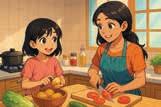
Think about and discuss these questions.
1. ‘I usually help my mom in the kitchen.’ Is the action happening right now or is it a routine?
2. ‘Right now, we are making dinner together.’ What does this sentence tell you about when the action is taking place?
3. In the sentence ‘My mom cooks tasty food,’ does the verb show what she usually does (Simple Present) or what she is doing right now (Present Continuous)?
4. What do you usually do to help your mom in the kitchen?
5. What do you not like doing in the kitchen?
We add -s or -es to an action verb when talking about he, she and it in the simple present tense. For example: My sister (She) eats the food. My father (He) washes the dishes

We use the simple present tense for habits, facts, general truths and things we do in the present time.
Time words used in the simple present are always, usually, often, every day/week/holiday, generally, sometimes, etc.
Positive Statements
Note: A positive statement in the simple present has ONE verb –is/are/am, has/have or an action verb.
Negative Statements
The sun is a star. (general truth) I always set the table. (habit) She usually eats/has lunch at 1 o’clock. (habit)
My mom cooks delicious food. (fact)
The moon is not/isn’t a star. I do not/don’t set the table. She does not/doesn’t have lunch at 1 o’clock.
Is the moon a star?
Do I set the table?
Questions
Note: When forming questions and negative statements, • is, are and am are always ready to do the work.
• action verbs like set and eat need do or does to help them.
• we use base form of verb with do or does.
Does she eat/have lunch at 1 o’clock? Does my mom cook delicious food?
We use the present continuous to show that things are happening right now. These actions continue at a time in the present. We use is/are/am + -ing form of the action verb.
Time words used in the present continuous are now, at the moment, at 4 o’clock, etc.
Positive Statements
Negative Statements
I am peeling the potatoes now. My sister is helping us, at the moment. We are making dinner now.
I am not peeling the potatoes now. My sister isn’t/is not helping us. We aren’t/are not making dinner together.
Questions
Am I peeling the potatoes now? Is my sister helping us?
Are we making dinner together?
Note: Sentences in the present continuous tense always have a helping verb (is/are/ am) and an action verb in the -ing form. We use the helping verb to form negatives and questions.

1. Stand in a circle.
2. Student 1: Mime an action and point to another student. Do actions like hopping, yawning, sniffing, coughing or crying.
3. Student 2: Name the action and make a sentence in the simple present tense. Use a time word and a name or a pronoun. For example: Aarav yawns every day. Then, point to someone else.
Write the following on the board.
Order
1. Mime 2. Statement
3. Question 4. Negative Time words
Simple Present: every day, always, usually, often, generally, sometimes
Present Continuous: at the moment, now
4. Student 3: Make a question. After that, point at another student. For example: Does Aarav yawn every day?
5. Student 4: Give a negative answer. Then, point to someone else. For example: He doesn’t yawn every day.
6. Students who have had their chance will sit down.
7. In the second round, make sentences, questions and negatives in the present continuous tense.
8. Keep alternating between simple present and present continuous until everyone has had a chance.




1. Tick ( ) the correct option in each sentence.
(a) The Ganga (flows / is flowing) through northern India.
(b) Right now, the children (learn / are learning) about the Brahmaputra River.
(c) The Yamuna (meets / is meeting) the Ganga at Allahabad.
(d) At the moment, our teacher (is explaining / explains) how rivers help farmers.
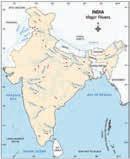

(e) Scientists regularly (measure / are measuring) the pollution levels in the Godavari River.
(f) There is a group who (does / is doing) research there right now.
2. Circle the correct verb in each sentence.
(a) We (swim / are swimming) after school every afternoon.
(b) My brother (doesn’t like / isn’t liking) the cold water.
(c) Look! The little ones (using / are using) their tubes.
(d) My dad (teach / is teaching) my sister to swim, at the moment.
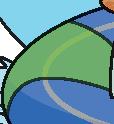

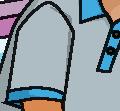




(e) Every Sunday, we (go / are going) to the pool at the sports club.
(f) There, the coach (teaches / is teaching) new swimming techniques.
(g) I (don’t think / doesn't think) I will go to the club today.

3. Fill in the blanks with the correct form of the verb in the simple present tense. Use the verb given in brackets.
(a) We (be) aware that we must save electricity wherever we can.
(b) We (switch) off the lights when we leave a room.
(c) My brother (not leave) the fan on at night.
(d) your family members (turn) off the kitchen light at night?
(e) you (know) why saving electricity is important?
(f) We (not only save) money when we use less electricity, but we also protect the environment.

4. Read about the festival of Baisakhi and fill in the blanks with verbs in the simple present or present continuous tense.
Every year, people in Punjab (a) (celebrate) Baisakhi. Children
(b) (wear) colourful clothes and (c) (dance) in the streets.
Right now, the villagers (d) (prepare) special sweets for the festival and everyone (e) (decorate) their homes. My family (f) (want) to go to the Baisakhi fair this year and my mother (g) (look) for places where we can stay.
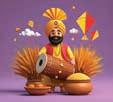
5. In your notebook, write a short story based on the picture. Use the simple present and the present continuous tense. Start with the words ‘Every year…’.
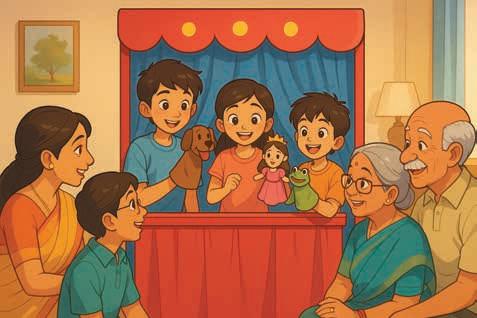








Read the conversation between Maya and Arjun.
Maya: Hey, did you go to Sam’s house yesterday evening?
Arjun: No, I didn’t. I was helping my mom in the kitchen. Why?
Maya: I heard Varun’s friends were decorating a room at Sam’s house for a surprise birthday party for him.
Arjun: Really? I didn’t know. Who was helping?
Maya: Sam and Neena were helping. Shalini and I weren’t able to go. We were finishing our project.
Arjun: I was busy and missed the fun. I am sure they had a great time.
Think about and discuss these questions.
1. What was Arjun doing while Varun’s friends were decorating the room at Sam’s house?
2. Did these actions happen in the past or the present?
3. Who else was not helping with the decorations?

We use the simple past tense to talk about something that happened in the past. The action was completed in the past.
Time words used in the simple past are yesterday, a week/day/month ago, in 1954, last week/year/summer, that night, etc.
Note: These statements have ONE verb - was/were or an action verb. Action verbs take an -ed or change completely.
Negative Statements
Arjun was busy that night.
Maya and Shalini were at Shalini’s house. They all missed the fun at Sam’s house yesterday.
Varun’s friends went to Sam’s house in the evening.
Varun’s friends had a great time.
Arjun wasn’t busy that night.
Maya and Shalini weren’t at Shalini’s house. They didn’t miss the fun at Sam’s house.
Varun’s friends didn’t go to Sam’s house.
Varun’s friends didn’t have a great time.
Questions Was Arjun busy that night?
Were Maya and Shalini at Shalini’s house?
Did they all miss the fun at Sam’s house?
Did Varun’s friends go to Sam’s house?
Didn’t Varun’s friends have a great time?
Note: The verbs was/were and did are used to form negatives and questions:
• Action verbs like missed and went need did to help them form questions.
• Had can also stand alone as a main verb and needs did to help form a negative statement.
We use the first form of verb with did or didn't in the past tense.
Wrong: I didn't went to the party.
Correct: I didn't go to the party.
We use the past continuous tense to talk about something that continued to happen at a certain time in the past.
Time words used in the past continuous are at that time, at 10 o’clock, etc.
Positive Statements
Negative Statements
I was helping my mom in the kitchen at that time.
Varun’s friends were decorating the room at 8 o’clock that evening.
Arjun wasn’t/was not helping his mom in the kitchen.
Varun’s friends weren’t/were not decorating the room.
Questions Was Arjun helping his mom in the kitchen?
Were Varun’s friends decorating the room?

Note: Sentences in the past continuous tense always have a helping verb (was/were) and an action verb in the -ing form. We use the helping verb to form negatives and questions.
We often use these two past tenses together. Note the time words while and when that show that one action was continuing at the moment when something else happened.
When Ajit arrived, Sam and Neena were decorating the room. (Simple past) (Past continuous – the action that was continuing when Ajit arrived)
While Sam and Neena were decorating the room, Ajit arrived. (Past continuous) (Simple past)



1. Prepare slips/cards with different prompts starting with ‘What were you doing when…’
For example:
• …the electricity went off?
• …your friend called you last night?
• …the teacher entered the class yesterday?
• …it suddenly started raining?
• …you heard a loud noise outside?
• …someone knocked at the door?
2. Divide the class into small groups or play as a whole class.
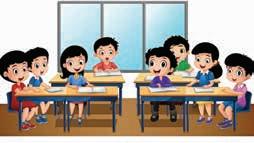
3. A student picks up a card and asks another student a question. The student must answer using the past continuous tense.
For example: I was reading a comic when the electricity went off.
4. This can be played as a chain game: Give each student a card with a question. The first student who answers their question, then picks another student and asks them a new one, keeping the flow going.


1. Read each sentence carefully. Circle the correct verb form (simple past or past continuous).
(a) The cyclists (started / were starting) the race at 9 a.m. sharp.
(b) The crowd (cheered / was cheering) loudly when the race began.
(c) I (watched / was watching) the race when my friend waved at me.
(d) My friend, Zishaan (didn’t finish / wasn’t finishing) the race because his tyre burst.
(e) While they (were riding / rode) their bikes, one of them (slipped / was slipping).
2. Fill in the blanks with the verbs in brackets using the simple past or past continuous. Priya and Aarav (a) (start) a big puzzle yesterday afternoon. They (b) (fit) the pieces together while they (c) (talk) and (d) (laugh).
While they (e) (look) for more pieces, Aarav suddenly (f) (find) the missing corner piece. Priya (g) (hold) up another piece and (h) (show) it to Aarav.
After some time, they (i) (finish) the puzzle. Then they (j) (decide) to play a board game. While they (k) (play), their mom (l) (bring) them some juice.
3. Read the passage and fill in the blanks with simple past or past continuous as needed.
Last week, our teacher (a) (ask) us why going to school matters. Some students (b) (say) it was only for exams, but she (c) (not agree). She (d) (give) us reasons why school matters.
At that moment, I (e) (not listen) carefully because I (f) (think) about yesterday’s football match. She noticed and (g) (ask) if I was paying attention.
Some verbs change their form in the past tense.
For example: go → went, eat → ate, make → made, etc
4. Write a diary entry about what happened when your parents brought a new dog home. What were you doing at that time, how did the pet behave when it arrived and how did you feel about it? (date) (time) (day)
Dear Diary,
Yesterday was the happiest day ever! My parents got a new dog. When they came home, I was…
(your name)








Bhavna and Yash are preparing a donation stall for their school fair. Read their conversation.
Will people arrive early tomorrow?

I think they will be arriving between 8 and 10 o’clock. Will you bring more books?


Yes, but he won’t bring anything, as he will be coming on his bicycle. Will you ask your cousin to come?
I won’t bring more books, but I will be collecting more used clothes from my friends tonight.
Think about and discuss these questions.
1. Are Bhavna and Yash talking about the present or the future?
2. Bhavna asks three questions. How do they start?
3. Yash said that he will not bring books. Which word is used instead of will not?
4. Read what Bhavna and Yash say in the first frame. What is the difference in meaning between people will arrive and people will be arriving?

We use the simple future tense to talk about things that will happen later. Time words used in the simple future are tomorrow, next week/month/year, etc.
Positive Statements
will + base form of the verb
Negative Statements
will not/won’t + base form of the verb
Questions
Will + subject + base form of the verb…?
People will arrive early tomorrow. He will come on his bicycle.
People will not/won’t arrive early tomorrow.
I will not/won’t bring more books.
Will people arrive early tomorrow? Will you bring more books?
We use the future continuous tense to talk about something that will or will not be happening at a certain time in the future. It is also used for planned events or actions that will continue for some time in the future.
Time words used in the future continuous are at that time tomorrow/next week/next year, at 3 o'clock tomorrow (at a certain time), etc.
Positive Statements will be + verb + -ing
At 4 p.m. tomorrow, they will be playing football with their team.
At this time tomorrow, I will be travelling to Shimla with my family.
Negative Statements
will not be/won’t be + verb + -ing
Questions
Will + subject + be + verb + -ing…?
At 4 p.m. tomorrow, they will not be playing football with their team.
I will not be travelling to Shimla with my family at this time tomorrow.
Will they be playing football with their team at 4 p.m. tomorrow?
Will you be travelling to Shimla with your family at this time tomorrow?
Note: Will is shortened to ’ll in positives. For example: I’ll be reading a storybook tomorrow Will not is shortened to won’t in negatives. For example: She won’t be watching TV tonight.


1. Players roll a dice and move forward.

Note: Players must answer with a complete idea. For example: We will have dal and rice for dinner tonight My parents will be watching TV at 8 o’clock this evening.
2. When they land on a block, they must answer the question in the simple future tense (will + verb) or the future continuous tense (will be + verb + ing).
Start
What will you have for dinner this evening? Who will you play with this afternoon? What will your parents be doing at 8 o’clock this evening? Miss a turn
Who will you visit this weekend? Miss a turn
What will you be doing at this time tomorrow? How will you be going home today?
Go back two spaces
Jump one step ahead
What will you do if it rains this weekend?
What will you do on Saturday? Go back two steps
Go back to start
What will you be doing at 12 o’clock tonight? Who will come and visit you this weekend?
Who will prepare your dinner tonight? What homework will you do this afternoon? Finish

1. Read each sentence carefully. Circle the correct verb form.
(a) Our teacher said that we (will be discussing / discussed) traditional clothes in class tomorrow.
(b) She (explains / will explain) the colours and patterns of Punjabi suits in tomorrow's class.
(c) We (will look / looked) at pictures of traditional dresses from Rajasthan next week.
(d) The class (will learn / learnt) about the Kerala mundu and set saree in the coming week.
(e) During the art period tomorrow, I (sketched / will be sketching) a Gujarati bandhani design.
(f) At this time tomorrow, students (will colour / will be colouring) in the designs of their costumes.

2. Fill in the blanks using the correct form of the simple future or the future continuous tense.
(a) The teacher (give) us cups and soil tomorrow.
(b) At this time tomorrow, we (plant) seeds in our cups.
(c) I (water) the seeds every day next week.

(d) Around this time next week, I (watch) the seeds sprout.
(e) The seeds (become) small plants after some weeks.

3. Read the passage and fill in the blanks with simple future or future continuous verbs, as needed.
This Diwali, our class is very excited. Tomorrow, we (a) (make) colourful lamps in the art class. At 10 o’clock, our teacher (b)
(explain) the steps to make the lamps. I (c) (paint) my lamp with bright colours and my friends (d)
(decorate) theirs with glitter. In the afternoon, we (e) (light) our lamps one by one. I (f) (not forget) to take a picture of my lamp.

4. Complete the dialogue with words or sentences.
Sanya is interviewing an artist.
Sanya: I hear you have an exhibition next year. When will it be?
Artist: It
Sanya:
Artist: I will have it in the town hall.
(question)
Sanya: Wow! Will you show your paintings there?
Artist: Yes, but I
Sanya:
(negative sentence)
(question)
Artist: Yes, I will most definitely be painting new pictures.
Sanya: That sounds exciting! Will you also be making sculptures?
Artist: No, .
(negative sentence)
Sanya: Thank you for your time!
5. Share your plans for the next summer holidays. Write a short paragraph, of 5–7 sentences, using the simple future tense and the future continuous tense.








Read the text.
The school playground was buzzing with excitement. Everyone gathered to watch the big football match between Class 4A and Class 4B. A student commentator stood near the field with a microphone, ready to give a lively play-by-play commentary.
‘The players runs onto the field,’ he shouted. The crowd went quiet for a moment. Something didn’t sound right. A few children whispered to each other. Something was off.
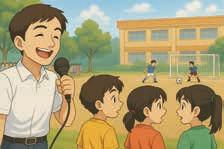
The commentator continued, ‘Ravi take the kick-off.’ The children looked at each other, trying to figure out what was wrong.
Think about and discuss these questions.
1. Why do the children feel something is wrong when the commentator said that the players runs onto the field ?
2. Which form of verb should be used with the subject Ravi in this sentence? Ravi take the kick-off.
3. Look at the two sentences above, what does it mean when we say that the subject of a sentence must match the verb used?
The subject of the sentence is who or what the sentence is about. The subject can be a noun or a pronoun like I, you, he, she, we, they or it

For a sentence to be grammatically correct, the subject and the verb must match or agree. We call this subject-verb agreement. A singular subject takes a singular verb, and a plural subject takes a plural verb.
The pronouns we use in the place of nouns are either singular or plural. Pronouns have matching verbs.
Singular Verb
I am/was/have
You (one) are/were/have
He/She/It is/was/has
Singular Verb
We (My mom and I) are/were/have
You (more than one) are/were/have
They (The players) are/were/have
We also know that in the simple present tense, an action verb takes an -s or -es with he, she and it.
For example: Singular Plural
Ravi runs onto the field! The players (They) run onto the field.
Anju scores a goal
Subject Type and Verb Form Examples
Uncountable nouns – singular
Milk is healthy. Sugar tastes sweet.
Collective nouns –singular The team scores a goal. The class has a new sports teacher.
Subjects joined with and – plural Riya and Sita are good players.
Coaches and fans cheer loudly.
Nishant and I (We) score a goal
Subject Type and Verb Form Examples
Plural pronouns like several, many, few, a few, both – plural
Many people enjoy cricket. Both girls train hard. When there or here is used, the subject comes after the verb – singular or plural depending on the subject
With some, use:
• singular verb with uncountable nouns
• plural verb with more than one of a countable noun
There is a football on the field.
There are many bats in the kit bag.
Some water is left in the bottle. (uncountable)
Some bats are broken. (countable)

Subjects joined with or, either/or, neither/nor – singular or plural (look at the noun closest to the verb)
Either the class teacher or the coaches are going. Neither the coach nor the player is ready.
Singular pronouns like each, nobody, everyone, every, somebody, anyone – singular Everyone is happy. Each child has a football. Nobody misses practice. Somebody is scoring a goal

1. Trace your hand in your notebook.
Names of subjects, games, books, films and diseases –singular
Physics is my favourite subject. Cricket is my favourite game. 'Ace Against Odds' is my favourite book.
Sometimes, the two things joined with ‘and’ form a single idea, then we use a singular verb. For example: Rice and curry is my favourite meal. Slow and steady wins the race.

2. Write the name of a character in the centre of the palm. For example: Shawn the rabbit
3. Write 5 verbs, one on each finger and thumb. For example: jump, run, sing, dance, talk
4. Create a short story about your character using the verbs you chose. Use the correct subjectverb agreement. Share it with the class.

Every morning, Shawn the rabbit wakes up full of energy. He jumps over the fence to explore the fields. Then he runs across the green grass, enjoying the fresh air. When he feels happy, he sings a little song and dances around the garden. In the evening, he and his best friend, Sandy, the squirrel talk about their adventures.


1. Sonam was late for class and missed the concept of subject-verb agreement. Help her by filling in the blanks with the correct verbs.
(a) Everyone excited about the performance. (is / am / are)
(b) The dancers ready on the stage. (is / am / are)
(c) I sitting in the front row with my friends. (is / am / are)
(d) The music very lively. (is / am / are)
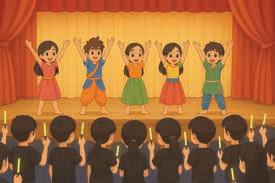
(e) Each dancer a colourful costume. (has / have)
(f) The students glow sticks in their hands. (has / have)
2. Choose the correct verbs from the box to compete the sentences. You may have to change the verb form.
reach sing come deliver spread has
There is an annual function organised in the school.
(a) Neither the principal nor the teachers planned the programme.
(b) The head girl a speech to welcome everyone.
(c) After that, the chief guests onto the stage.
(d) Both Akshi and Leha their favourite songs.
(e) There is silence as they for the highest notes.
3. In your notebook, rewrite the sentences using the correct verb forms.
(a) The news about the kite festival make everyone come together.
(b) My brother arrange the wooden sticks.
(c) Both my sisters chooses colourful paper.

(d) Either my uncle or my cousins has brought ribbons for the tail.
(e) Each child draw a small design to decorate the kite.
(f) There is many suggestions about what to do.
(g) Everyone smile happily when the kite is ready.
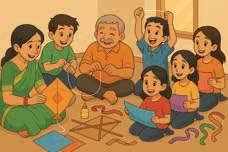
4. Abdul recently went to New Delhi and wrote a diary entry after coming back. Fill in the blanks with the correct verb forms.
25 August 2025
8 p.m.
Monday
Dear Diary,
I recently (a) (go / went) to Delhi and noticed the poor air quality. Delhi (b) (have / has) many beautiful sights, but the air (c) (feels / feel) very dirty. Smoke from vehicles and factories (d) (make / makes) it hard to breathe.
Adults (e) (cough / coughs) and children (f) (become / becomes) sick.
Trees and plants (g) (release / releases) clean air, but many areas (h) (lack / lacks) greenery. Everyone (i) (have / has) a duty to plant trees and avoid burning fuel. Every small effort (j) (help / helps) to improve the environment.
Abdul








Read to find out why Grandma is laughing.
Radha: Grandma, please check my assignment.
Grandma: Sure, dear.
(Grandma starts reading and suddenly bursts out laughing.)
Radha (confused): Why are you laughing?
Grandma: You wrote ‘Let’s eat Ruhani.’
Radha: What’s wrong with that?
Grandma (smiling): It sounds as if you want to eat Ruhani for dinner! It should be ‘Let’s eat, Ruhani.’
Think about and discuss these questions.
1. When Grandma read Radha’s line, why did it sound so funny?
2. How is ‘Let’s eat Ruhani’ different from ‘Let’s eat, Ruhani’?
3. Why has an apostrophe (’) been used in ‘Let’s eat, Ruhani.’

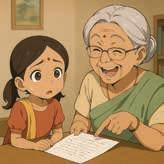
An apostrophe is used to show belonging (Radha’s assignment) or in contractions (What’s = What is).
Punctuation marks are special signs that we use when writing to show pauses, stops, questions or feelings. They help us make sense of sentences and understand the writer’s meaning clearly
Capital Letters
• The pronoun ‘I’ is always capitalised.
• All proper nouns begin with capital letters.
• A new sentence begins with a capital letter.
• Days of the week and the names of months begin with capital letters.
• Priya and I help stray dogs. (not ‘i’)
• New Delhi is the capital of India.
• She is an intelligent girl.
• I was born in November.
Full stop (.)
Comma (,)
Question Mark (?)
Exclamation Mark (!)
• Used to mark the end of declarative sentences that state a fact, an idea or an opinion
• Used to separate words in a list
Apostrophe (’)
• After ‘Yes’ or ‘No’
• Used after/before someone’s name, if it is at the beginning/end of the sentence
• Used at the end of a question (an interrogative sentence)
• Used at the end of exclamatory sentences
• Also used after interjections
• To show possession
• Used in contractions
Note: Sometimes, exclamatory sentences begin with ‘wh’ words.
For example: What a lovely view!
It is an exclamatory sentence because it shows strong emotion. So, an exclamation mark (!) will be used at the end of the sentence and not a question mark (?).
• I like to swim in the evening
• She bought potatoes, tomatoes, chillies and butter.
• Yes, I know the answer.
• Let’s eat, Ruhani.
• Piyush, sit down.
• Which book do you want?
• Look how beautiful the peacock is!
• Hurrah! We won.
• This is Radha’s dog.
• You’re the captain.
Remember!
‘You’re’ and ‘your’ sound similar but they are very different.
‘Your’ shows possession whereas ‘you’re’ is a contraction of ‘you are’. Your grandmother is kind. ( ) You’re grandmother is kind. ( )


1. Take an A4 sheet and divide it into four parts.
2. Draw these punctuation marks, each in a different section:
Full stop (.) – colour it green
Comma (,) – colour it blue
Exclamation mark (!) – colour it red
Question mark (?) – colour it orange
3. Cut the sheet into four flashcards.
4. When your teacher writes a sentence on the board, hold up the flashcard that shows the missing punctuation mark.


You may give a variety of sentences to assess learners’ understanding of punctuation. Teacher Tip!
1. Some children went exploring and discovered a treasure. Circle the correct punctuation marks to complete the sentences.
(a) Yesterday, we went to the old fort (! /. /?)
(b) Suddenly, Rina shouted, ‘Look, I found a map!’ The map showed gold coins (. /, /!) silver rings and sparkling jewels.
(c) Arjun asked, ‘ Where should we start digging (. /! /?)’
(d) Maya whispered, ‘I think the treasure is hidden under that big tree (. / ! / ?)’
(e) Hooray (! /, /?) We have found the treasure.
(f) Can you believe our luck (’/. /?)
2. Match the following.
You are
She is
They are
I am
That is
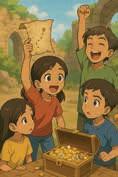
She’s
They’re
That’s
You’re
I’m
Now, make sentences using the contractions in your notebook.
For example: You're my best friend.
3. In your notebook, rewrite the sentences correctly. Use capital letters and the correct punctuation marks.
(a) last winter, we went for a camel safari in rajasthan
(b) the desert was hot during the day and very cold at night
(c) we saw sand dunes camels and small villages
(d) the guides stories were very interesting He gave us many facts about the desert
(e) the camels back was very high we had to climb up carefully
(f) wow the ride on its back was so much fun
4. Vansh writes a letter to his friend and tells him about his hometown. There are some punctuation errors. In your notebook, rewrite the letter correctly. Use capital letters, full stops, commas, apostrophes, question marks and exclamation marks where needed.
123, Civil Lines
New Delhi 110098
1 October 20XX
Dear Ritvik
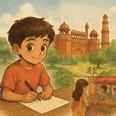
how are you i hope you are fine i want to tell you about my hometown new delhi is the capital city of india there are many old buildings like the red fort the qutb minar and the india gate people from many countries come to see these sights delhi also has busy markets where we can buy toys clothes and many other things the street snacks are very tasty there are also many green parks where children play games and have fun i love my city would you like to visit someday
Your friend
Vansh
Time: 40 mins
Total: 25 Marks
1. Convert each sentence into either a negative sentence OR a question as directed. (5 × 1 = 5 marks)
(a) Marina Beach is in Chennai.
Question:
(b) People are enjoying the cool breeze at the beach.
Negative:
(c) People speak Tamil in Chennai.
Question:
(d) The kids enjoyed coconut water at the beach yesterday.
Negative:
(e) The food stalls were crowded because it was Sunday.
Negative:
2. Tick ( ) the correct verb form. (6 × ¹/₂ = 3 marks)
Anshika loves exploring the outdoors. Every morning, she (a) (walks / walked) through the park near her house. One day, she (b) (sees / saw) a colourful parrot sitting on a branch. She quickly (c) (took / is taking) out her sketchbook to draw it.
While she (d) (is sketching / was sketching), a puppy ran across the path. It (e) (is chasing / was chasing) a butterfly. Anshika laughed aloud and said, ‘I (f) (am enjoying / was enjoying) this beautiful day so much.'
3. Fill in the blanks to complete the questions and the negative statements about Anshika’s day.
(4 × ¹/₂ = 2 marks)
(a) Anshika sitting on a bench yesterday when she saw the parrot?
(b) No, she , she was walking through the park.
(c) she complete the sketch of the parrot?
(d) No, .
4. Write a short message of about five sentences to your cousin, telling him or her about your plan to visit them during the Durga Puja break. Use both the simple future tense and the future continuous tense in your message. (5 × 1 = 5 marks)
Hints: I will visit you during the Durga Puja holidays. (Simple Future)
During that time, we will be going to the pandals together. (Future Continuous)
5. Fill in the blanks with the form of the verb that agrees with the subject. (5 × 1 = 5 marks)
(a) The pilot (check / checks) all the instruments before takeoff.
(b) The pilot and the co-pilot (review / reviews) the flight plan carefully.
(c) During bad weather, the pilots (remain / remains) calm and focussed.
(d) The cabin crew (assist / assists) passengers while the plane is in the air.
(e) On long flights, either the pilot or the air hostesses (make / makes) announcements.
6. Rewrite the sentences using the correct capitalisation and punctuation. (5 × 1 = 5 marks)
(a) it is anyas first trip as an astronaut
(b) the trip to mars has been scheduled for may
(c) she has been practising how to put on her suit gloves helmet and boots
(d) wow she looks so smart in her outfit
(e) she has been interviewed by rajit sharma
A collective noun is a word that names a group of people, animals or things as a single unit.
Group Noun
flock birds, sheep pack wolves, cards
swarm bees team players
school/shoalfish bunch grapes, flowers
bench/panel/juryjudges herd cows, elephants galaxy stars
crowd/group people, guests, children
Group Noun
colony ants, bats
troop monkeys, soldiers pride lions band musicians fleet ships army soldiers, caterpillars
crew sailors
kennel/packdogs
stack/pilebooks, notebooks choir singers
1. Fill in the blanks with the correct collective nouns.
(a) A of birds flew across the sky on their way south.
(b) The of ants worked together near the tree.
(c) A of wolves howled loudly in the forest at night.

(d) The of monkeys swung from branch to branch in the jungle.
(e) A of bees buzzed around the blooming flowers.
(f) A of lions rested in the shade after hunting.
(g) Our school’s basketball won the championship this year.
(h) The musicians formed a and played lovely tunes at the festival.
(i) A of fish swam together near the coral reef.
(j) The navy sent a of ships to patrol the coast.
A prefix is a group of letters added to the beginning of the root word. It changes the meaning of the root. Prefixes can be used to form antonyms (opposites) of the root forms. in- incorrect, invisible un- unknown, unsafe im- improper, impatient non- non-fiction, nontoxic re- rebuild, revisit dis- disconnect, dislike de- defrost, decompose mis- misunderstand, misuse
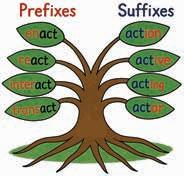
A suffix is a group of letters added to the end of the root word. They have different functions. Form plurals: gifts, quizzes Show possession: aunt’s, Gina’s Compare: faster, fastest Show tense: skidded, sipping Change one kind of word to another, e.g. verb to noun and noun to adjective: act – actor, paint – painting, care – careless, danger – dangerous
Note: The middle consonants double only if the root word: • is a single syllable, • ends with one consonant and • has only one vowel.
1. Complete the puzzle by writing prefixes in the coloured boxes to form antonyms.

2. Fill in the blanks by adding a prefix or a suffix to the words in brackets.
Our science (a) (teach) warned us not to (b) (use) laboratory (c) (equip) and said that students would be (d) (punish) if they are (e) (care). She explained that it was (f) (safe) to use too much heat to (g) (frost) frozen liquids because the glass (h) (beaker) could break. The (i) (proper) handling of these items could be (j) (danger). She also showed us what to expect while (k) (heat) different kinds of (l) (gas). Finally, she warned us that heating (m) (known) chemicals could lead to an (n) (explode). I am sure that our science classes will now be (o) (safe) than before.
Antonyms are words that have opposite meanings.
Nishant opened the door for the dog. Nishant closed the door because it was windy.
Word Antonym rude/impolitepolite under over early late ancient/oldmodern wise/cleverfoolish shallow deep sorrow joy narrow wide increase decrease accept reject forget remember pause resume
Word Antonym win lose heavy light inside outside hopeful hopeless careless careful/responsible borrow lend tidy/neat untidy/messy near far/distant smooth rough maximum minimum noisy silent protect harm
One way to make antonyms is by adding certain prefixes before the word like im-, ir-, dis-, in-, un- and il-.
Add im-
Add ir-
Add disperfect – imperfect responsible – irresponsiblehonest – dishonest possible – impossibleregular – irregular agree – disagree patient – impatient replaceable – irreplaceableappear – disappear polite – impolite relevant – irrelevantobey – disobey
Add in-
Add il-
Add uncorrect – incorrect legal – illegal pleasant – unpleasant visible – invisible logical – illogical kind – unkind complete – incompleteliterate – illiterate grateful – ungrateful
1. Make antonyms by using the prefixes mentioned in the help box. im- ir- dis- il- un- in-
(a) polite →
(c) active →
(e) kind →
(g) responsible →
(b) legal →
(d) honest →
(f) complete →
(h) visible →
2. Use antonyms of the underlined words to fill in the blanks. It was a bright morning, and the children were on their way to school.
Aman looked at the path and said, ‘This lane is very narrow.’ Ravi replied, ‘No, it is quite (a) .’
Ritika pointed to a house. ‘That old building looks ancient.’
Manisha smiled, ‘Yes, and the one next to it seems
(b) .’ In class, Rajan said, ‘I always forget this language rule.’ ‘If you practise, you’ll (c) it,’ said the teacher.
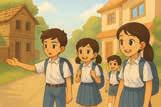
During recess, Meena said, ‘I’m happy with my quiz results.’ Seema sighed, ‘I’m (d) with mine!’ At the end of the day, Rajiv whispered, ‘This noisy classroom will finally be (e) when the bell rings.’
3. Look at the image carefully. In your notebook, write a short story of 100–150 words. Remember to include at least THREE antonyms in your story.
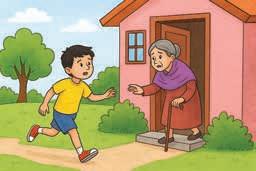
We use one word for a phrase when we want to say something in a shorter and better way. Instead of many words, we use just one word that has the same meaning. For example: Many words (phrase) – A place where books are kept One word – Library
Here are some examples of phrases that can replaced by single words. A book that tells the meanings of words Dictionary
A person who draws maps Cartographer
A person who studies the stars and planets Astronomer
A person who studies plants Botanist
A person who travels into space Astronaut
A person who makes bread Baker
A person who sells medicines Chemist/Pharmacist
A person who studies animals Zoologist
A person who makes furniture with wood Carpenter
A person who writes books Author
The life story of a person written by someone else Biography
A person who believes in god Theist
A person who repairs cars Mechanic
A person who acts in plays or films Actor/Actress
Own life story written by a person Autobiography
A person who does not believe in god Atheist
Sometimes, instead of saying very + word, we can use a strong word. This makes our sentences powerful and interesting. very tasty delicious very smart intelligent very hungry starving very tired exhausted very big huge very small tiny very happy joyful/cheerful very sad miserable very funny hilarious very scared terrified very angry furious very cold freezing
1. Imagine you are a student in Ms Shamita’s classroom. Read the dialogue and write the one-word answers.
(a) Ms Shamita: What do we call a person who makes bread?
(b) Ms Shamita: Siya’s mother loves stars and planets. She studies them. What would you call her?
(c) Ms Shamita: What do you call a person who is trained to repair cars?
(d) Ms Shamita: We read the life story of Mahatma Gandhi, written by R Guha. What do we call this book?
2. Underline the option that replaces the words in bold.
(a) Meena is a very interested mouse who is always exploring. (furious / curious)
(b) One day, she was very hungry! (starving / freezing)
(c) When looking for cheese, a big fat cat chased her. Meena was very scared. (terrified / joyful)
(d) The cat was faster than she was, and she was very tired by the time she found her hole. (glad / exhausted)
(e) From the hole, Meena saw another mouse slip on butter, and it looked very funny. (hilarious / freezing)
Vocabulary
Word
Phrase
Compound words are made by joining two words to create a new word with a different meaning.
For example: sun + flower = sunflower butter + fly = butterfly air + port = airport Types of Compound Words
One-Word Compound Words: The two words are written together as one single word.
For example: snow + man = snowman
Two-Word Compound Words: The two words are written separately, but together they have a new meaning.
For example: post + office = post office
Let’s look at a few more compound words.
Note: Do not guess whether a compound word is one word or two words. Always use a dictionary to check the correct form.
One-Word Compound Words
Two-Word Compound Words
rain + bow = rainbow ice + cream = ice cream
note + book = notebook washing + machine = washing machine
foot + ball = football full + moon = full moon
1. Match the words in column A and column B to make compound words. Write the new words in the space provided.
Column A
Column B
Compound Word foot chain key stop traffic path bus phone smart light
2. Circle the one-word and underline the two-word compound words in each sentence. Let me tell you about last Sunday.
(a) We went to the new swimming pool near the playground.
(b) My father got us cupcakes and put them on the dining table.
(c) We also planned a trip to a hill station, where we may see a waterfall.
(d) My mom served my father tea in a teacup that was placed on the coffee table.
(e) We also read the newspaper and watched the full moon in the night sky.
3. Look at the image and fill in the blanks with the correct compound words. It was Monday. I got ready for school.
(a) I brushed my teeth with my .
(b) I opened the door when the rang.
(c) My mother packed my food in a .
(d) I wore a to school because it was raining.
(e) In the evening, my dad brought me a new .
Words can have a similar meaning but still show different feelings or strengths of feeling. These differences are called shades of meaning. It is like a colour scale of orange that goes from light orange to darker orange.
For example: big huge enormous
Let us look at some more words that mean the same but differ in intensity (strength).
sadunhappymiserable
She was sad when she lost her toy, unhappy when she lost her book and miserable when she lost her pet.
happyjoyfuldelighted He was happy to see his dog, joyful when it wagged its tail and delighted when it jumped into his arms.
scaredafraidterrified I was scared of the dark, afraid when the lights went out and terrified when I heard the loud thunder.
coldchillyfreezing It was cold in the capital city, chilly in the mountains and freezing in the snow.
warmhotboiling It is healthy to drink warm water in the morning, and we drink our tea hot but not boiling.
annoyedangryfurious She was annoyed when her brother teased her, angry when he broke her toy and furious when he tore her photo album.
nicekindgenerous He was nice to say hello, kind to share his pencil and generous to give away his lunch.
smartcleverbrilliant
She is a smart girl who is clever at solving puzzles, but she is brilliant at coding.
amusingfunnyhilarious The clown’s act was amusing, his jokes were funny and the closing was hilarious.
1. Read the story and tick ( ) the best word from the brackets to complete it.
(a) Scooby entered the haunted house. The room was (cool / freezing) and he started to shiver.
(b) Shaggy dropped his sandwich. He looked (sad / miserable) but at least he had another one.
(c) Velma heard an evil laugh in the dark and was (scared / terrified) when she felt someone close.

(d) Fred was (happy / delighted) when he found a secret map under the carpet.
(e) Scooby was (annoyed / furious) when the ghost stole his Scooby Snacks!
2. Arrange the words in the correct order of intensity (from least strong → most strong).
(a) small, microscopic, tiny
(b) amusing, hilarious, funny
(c) dirty, filthy, messy
(d) mean, cruel, rude
(e) exhausted, sleepy, tired
3. Choose any THREE sets of words from the above exercise and make your own sentences to show the difference in intensity.

A smile can brighten up the day, And chase the little clouds away. A gentle word, a helping hand, Can spread some joy across the land.
A tiny act, so small, so sweet, Can make new friends with all we meet.
A door held wide, a chair to share, Shows someone else how much we care.
Kindness is a gift we give, It makes all happy while we live.
The more we spread, the more it grows, Like sunshine where the soft wind blows.
1. Tick ( ) the correct option.
(a) What can a smile do in the poem?
i. Make people angry
iii. Build a house
ii. Brighten up the day
iv. Stop the rain
(b) Which of these is an act of kindness mentioned in the poem?
i. Singing loudly
iii. Drawing a picture
ii. Running fast
iv. Helping someone
(c) What do you think the ‘little clouds’ may refer to?
i. Small problems
iii. Storm clouds
ii. Pollution
iv. Bad dreams
(d) How does kindness grow, according to the poet?
i. Like a candle melting
iii. Like falling rain
ii. Like a tall mountain
iv. Like sunshine
2. Write True or False.
(a) Kindness makes both the giver and receiver happy.
(b) The poem says kindness only works if it is big and grand.
(c) Speaking to someone kindly and gently is given as an example of kindness.
(d) Kindness is compared to a gift that we give someone.
3. Find a word from the poem that means the same as the words given. Then, use them in sentences of your own.
(a) lighten:
(b) happiness:
(c) present:
4. Answer the following questions.
(a) Name the two small acts of kindness mentioned in stanza 2. Use your own words.
(b) What happens when we spread kindness?
(c) Why does the poet compare kindness to sunshine?
(d) Do you think small acts of kindness are as important as big ones?
Mary Kom is one of India’s most famous sports stars. She is a boxer who has made the country proud. She was born in a small village in Manipur, in the north-eastern part of India. When she was young, she loved sports and often played outside. She worked very hard to follow her dream of becoming a boxer.
At first, people told her that boxing was not for girls, but Mary did not give up. She trained every day and showed courage and determination. Soon, she began winning medals in competitions. In 2012, she became the first Indian woman boxer to win a medal at the Olympic Games.
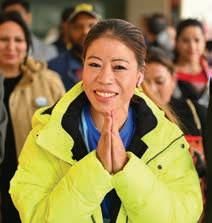
Mary Kom has won the World Amateur Boxing Championship six times, which is a world record. Even after becoming a mother of four children, she continued to box and win. Her final game was in 2021 and she officially retired in 2024.
Mary Kom’s story inspires many young boys and girls to work hard and not to give up. She has lived up to her nickname ‘Magnificent Mary.’ She teaches us that with courage, hard work and self-belief, we can achieve great success, no matter where we come from.
1. Fill in the blanks.
(a) Mary Kom became the first Indian woman boxer to win a medal at the .
(b) She has won the World Amateur Boxing Championship times.
2. State True or False.
(a) Mary Kom showed an interest in sports from a young age.
(b) In the beginning, people encouraged Mary Kom to take up boxing.
(c) Mary Kom retired in the year 2021 after her final match.
(d) Mary Kom is also called ‘Magnificent Mary.’
(e) Mary Kom reminds us that it matters where we come from.
3. Find one word in the passage that means the same as these phrases.
(a) The ability to carr y on even in tough times
(b) Events that are arranged to find the best performer/performers
(c) Stopped working after many years of work
(d) The best or highest achievement
4. Answer the following questions in one or two sentences.
(a) Write two qualities that led to Mary Kom’s success as a boxer.
(b) Which world record does Mary Kom hold?
(c) Why do you think Mary Kom did not give up even when people said boxing was not for girls?
(d) What can we learn from Mary Kom’s life?

Arushi loved drawing. She filled her notebooks with sketches of birds, trees and animals. One day, her school announced an art competition. Arushi was very excited but also nervous. She painted a scene of a deer drinking water near a forest stream. For days, she worked carefully, adding bright colours and fine details. On the morning of the competition, she proudly carried her painting to school. Just as she stepped down from the bus, she noticed a stray puppy limping near the gate. Its paw was hurt and it looked scared.
Arushi quickly put down her painting and gently went towards the puppy. Her friends tried to stop her but she wouldn’t budge. She used her handkerchief to tie around its paw and gave it some water from her bottle. The bus in-charge saw Arushi and came by. He warned Arushi to be careful around stray animals and then took the puppy to the animal shelter. In the meantime, Arushi’s painting got smudged and dirty.
Although she had no neat painting to submit, the judges learnt what she had done. They praised Arushi for her empathy, reminding everyone that caring for animals is also a beautiful kind of art.
1. Tick ( ) the correct option.
(a) What did Arushi enjoy most?
i. Reading stories
ii. Drawing pictures
iii. Playing football
iv. Singing songs
(b) What was the subject of Arushi’s painting?
i. A peacock in the forest
ii. A deer drinking water
iii. An injured puppy
iv. An animal shelter
(c) Why did Arushi’s painting get smudged and dirty?
i. It was ruined by rain.
ii. She dropped it in mud.
iii. She left it aside while helping a puppy.
iv. It was torn by her friends.
2. Fill in the blanks.
(a) Arushi used her to tie the puppy’s paw.
(b) The bus in-charge took the puppy to the .
3. Answer the following questions in one or two sentences.
(a) What did Arushi do when she saw the injured puppy?
(b) What did the bus in-charge do after Arushi helped the puppy? What kind of a person is he?
(c) What lesson can we learn from the story?
4. Write the meaning of the words from the passage.
(a) limping:
(b) stream:
Imraan and his family were travelling by train from Delhi to Katihar to attend his cousin’s wedding. The morning sun shone brightly as the train left the busy Delhi station. The train was crowded, with families chatting, children laughing and with vendors selling tea, samosas and magazines. Imraan held his ticket carefully and sat near the window, eager to see the changing views.
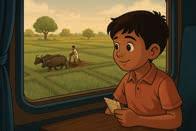
As the train picked up speed, he noticed wide green fields, buffaloes grazing and farmers working with their ploughs. He also saw small rivers shining in the sunlight and children waving at the passing train from village roads. When the train stopped at the Bareilly station, the platform came alive with the smell of hot pakoras and the sound of people calling out for snacks and tea.
In their coach, Imraan noticed an elderly man sitting alone with a small bag beside him. He looked tired but gentle. When the train stopped at Lucknow station, Imraan’s mother opened her tiffin and offered the man some homemade puris and vegetables. The man’s eyes brightened. He smiled warmly and said, ‘Thank you. This reminds me of the food my wife used to pack for me.’ The man said that he was going to Patna. Soon, he began sharing stories about his childhood train journeys—how he would travel with his friends to fairs and sit by the window just like Imraan.
Imraan listened carefully, enjoying the stories. His father joined in and soon everyone in the compartment was smiling and talking. The long journey no longer felt tiring. Imraan realised that train journeys were not only about reaching a destination but also about meeting people, sharing kindness and creating memories. By the time they reached Katihar, Imraan felt happy that he had made a new friend during the journey.
1. Tick ( ) the correct option.
(a) Where was Imraan travelling with his family?
i. To Katihar
iii. To Delhi
ii. To Lucknow
iv. To Patna
(b) What did Imraan see outside the train window?
i. Children playing cricket
iii. Large mountains
ii. People shopping in a market
iv. Farmers working in the fields
(c) Who did Imraan’s mother share food with?
i. A child
iii. An elderly man
2. Fill in the blanks.
ii. A vendor
iv. A station master
(a) Imraan held his carefully and sat near the window.
(b) The Bareilly station platform was filled with the smell of hot .
(c) The elderly man in the coach was reminded of .
3. Find antonyms from the passage for the following words and use them in sentences of your own.
(a) empty:
(b) mean:
4. Answer the following questions in one to two sentences.
(a) Why was Imraan travelling to Katihar?
(b) What things did Imraan notice while looking outside the train?
(c) How did the elderly man feel when Imraan’s mother shared her food?
(d) What kind of stories did the elderly man share with Imraan?
(e) What lesson did Imraan learn from the train journey?
Message writing is a simple way to share important information with someone when you can’t tell them in person. It is used in schools, offices and even at home to pass on messages clearly and quickly.
Imagine that you are Shanvi and that your mother is not at home. Mr Sinha, the community manager, calls to tell your mother that the community event has been postponed until the next day at 5 o’clock, but the venue is still the same. You have to attend a music class. Leave a message for your mother.
13 June 2026
11:15 a.m.
Hi Mom,
Mr Sinha, the community manager, called to inform you that the community programme has been postponed to 5 p.m. tomorrow. The venue is still the same. I thought I should let you know, so you don’t go today. I am going for my classes and will be back by 7 p.m. Shanvi
Note:
1. A message should be enclosed in a box.
2. Use the format that is shown.
3. The word limit should be around fifty words.
4. Messages can be written in an informal or a formal tone.
Write short messages according to these instructions.
1. You are Rishabh’s sister. Read the conversation between you and Ayaan, Rishabh’s friend.
Ayaan: Hello, I am Ayaan, Rishabh’s friend, may I speak to him please?
You: Hi, Ayaan! I am Rishabh’s sister. He has gone out to buy some snacks.
Ayaan: Oh, okay.
You: I hope everything is fine. Rishabh mentioned that you will be visiting us today.
Ayaan: Yes, I was supposed to, but I’m not feeling well.
You: Oh no, I’m sorry to hear that. Should I tell Rishabh?
Ayaan: Yes, please. I was really looking forward to playing video games with him, but I need to rest.
You: No problem, I’ll give him your message. Please take care and get well soon. You have to leave for your dance classes. Write a message to your brother informing him that Ayaan is sick and will not come today.
2. Sneha was absent from school today. During class, the teacher announced that there will be a maths test on Friday. Kashika decides to inform Sneha and gives her a call. Read the conversation.
Kashika: Hello, this is Kashika. Is Sneha at home?
Zohaan: Hi, I’m her younger brother. Sneha isn’t at home right now.
Kashika: Oh, okay. I just wanted to tell her that there is a maths test on Friday.
Zohaan: All right. I’ll tell her.
Kashika: The teacher said that the test will cover Chapters 3 and 4.
Zohaan: Got it. Anything else?
Kashika: Yes, she should also revise the class notes.
Zohaan: Okay, I’ll let her know. Thank you so much.
Zohaan has to leave for his football classes. He decides to write a message for Sneha. Imagine you are Zohaan and write a message in about 50 words.
A notice is a short piece of writing used to give information to a group of people. It is displayed in public places. It is always written in simple, clear language and placed in a box.
Aniket Singh, club secretary at the Happy Model High School, issued a notice about the launch of a Coding Club at school.
22 July 20XX
Launch of a New Coding Club
This is to inform you about the launch of a new Coding Club. Interested students of grades 3 to 5 are invited to the launch. The details are:
Date: 10 August 20XX
Time: 9:00 a.m. to 3:00 p.m.
Venue: School Auditorium
An introductory session will be held in the Computer Lab on 27 July at 10 o’clock. Join the session to find out more about the activities planned and how you can learn coding in an easy and fun way.
For more information, please contact Mrs Kaur.
Aniket Singh Club Secretary
Name of the school/institution Header Date
Title/Subject
Main body of the notice
• What, when, where and who it is for
• What the readers should do
• Contact information
Name and details of the person issuing the notice
Write the notice in about 50–60 words.
1. Your school is organising a Christmas Fair on the football ground. As the class monitor, your teacher has asked you to write a notice informing students about the fair and inviting them to attend a meeting to plan what the class will do.
2. You are the Sports Captain of your school. Write a notice informing classes 4 and 5 students about an upcoming cricket match between these two grades.
3. You are the Head Boy/Head Girl of your school. Write a notice about the upcoming Drama Competition at your school and invite students to participate.
4. As a class monitor, your teacher has asked you to write a notice inviting students of grades 3–5 to an exhibition of the best science projects.
5. Write a notice to members of your community to donate clothes and food for people who lost their homes in a flood. Also mention when and where people can drop off their donations.
A paragraph is a group of sentences about one main idea. It has a topic sentence, supporting sentences and a concluding sentence.
Viswanathan Anand is one of India’s greatest chess players. He is called the ‘Tiger of Madras’. Anand became the first Indian to win the World Chess Championship. He has won many international titles and has made India proud. He is known for his quick thinking and calm manner. He is still one of the leading chess masters in the world and an inspiration to many young chess players.
Write a paragraph of between 40–60 words.
Topic Sentence – opening sentence that tells the reader what the paragraph is about
Supporting Sentences –describe, explain or give examples
Concluding Sentence – a final thought or summary
1. Write about the most beautiful place you have ever visited. Use these hints to write it.
• Where did you visit?
• Who went with you?
• What did you do?
• Why did you like the place?
• What did you see there?
• What was the most memorable part of the visit?
2. Use the information given in the box to write a paragraph about ‘Dr A.P.J. Abdul Kalam’.
• India’s most respected leader
• Worked in science and space research
• Believed in hard work and honesty
• Missile Man of India
• 11th President of India
• Inspired us to serve the nation
3. Write a paragraph on ‘My Big Day’. Write about an incident where your bravery, quick thinking or kindness made a big difference.
4. ‘The Mystery in My School Bag’ Something strange appears in your school bag. Write about what it is and what happens.
An informal letter is a friendly letter written to family or friends. It is personal and conversational, and written in a friendly tone.
Keshav wrote to his grandfather, telling him about his plans to visit during the Diwali holiday.
Model Answer
B224, Saket
New Delhi 110XX8
2 September 20XX
Dear Grandfather,
I hope you and Grandmother are well. I miss both of you a lot and want to share some exciting news.
We are planning to visit the village during the Diwali holiday. I cannot wait to meet you and Grandmother and celebrate Diwali together. It will be so much fun to light diyas, eat sweets and enjoy the festival with the whole family. I’m also bringing some sweets and gifts from the city for both of you.
Please let me know if there’s anything special you’d like me to bring from here.
Please take care of yourself and give my love to Grandmother.
Yours lovingly, Keshav
Sender’s address and code
Date when the sender writes the letter
Greeting (with a comma)
Introduction – start with a personal touch and mention the purpose of the letter
Main Content – write the main message and share details about your plans, feelings or events
Closing Lines – say something kind and personal
Sign-off and your name
1. Write a letter to your friend who is sick and has not attended school for a week. Ask about his health and offer to help him by sending class notes.
2. Write a letter to your cousin telling him/her about your plan to visit them during the summer vacation. Share some old memories of experiences you both had together.
3. Write a letter to your elder brother/sister congratulating him/her on becoming a doctor after completing college. Also mention how he/she inspires you.
A good story has characters, a setting, and a clear beginning, middle and end. The aim of telling a story is to entertain your readers.
The school playground was full of noise and cheers. Class 4A was playing against Class 4B in the final football match. Ankur was the captain of Class 4A, and everyone was counting on him.
In the middle of the game, the ball rolled quickly towards the goal, but Ankur slipped and missed his kick! For a moment, the team looked worried. Class 4B was about to score.
Just then, Ankur got up, ran faster and passed the ball to his teammate, Piyush. Piyush kicked hard— and scored a goal! The crowd clapped and shouted with joy.
Even though Ankur had made a mistake, he didn’t give up. With good teamwork, Class 4A won the match. Ankur learnt that playing together is more important than being perfect.
Write a story of about 100 words with a suitable title.
1. Write a story based on the pictures.
2. Imagine that something funny or surprising happens at your school Sports Day. Write about what happened and how it all ended.
3. Imagine that the tree at your window starts talking to you. Write about your surprise, what the tree said and what you did next.
of
Introduction - introduce the characters and setting, mention the problem to capture the interest of your readers
Body - build the story by telling what happens and include exciting details
Closing paragraph - say what happened in the end and close with a line that your readers will remember
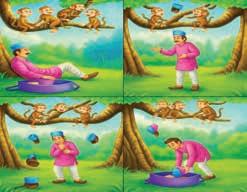
We can write an essay to share our thoughts or opinions on a subject. We can share information, describe a scene or experience or give our views on a topic.
1. An essay has at least three paragraphs – an introduction, a body paragraph and a concluding paragraph.
2. Interesting ideas make an essay fun to read so think carefully about what you can say.
Title: It says what the essay is about.
Introduction: What the essay is about. It must motivate your readers to read the rest!
Body: It gives a few clear reasons why the writer likes reading stories.
Conclusion: It is a short summary of what has been said but using different words. End with a strong sentence!
I enjoy reading fiction more than non-fiction because stories take me to exciting places. Fiction stories are full of adventure, mystery, and fun characters that make reading feel like a journey. While non-fiction gives facts and real information, fiction makes me escape into the world of the characters. Fiction books often have magical lands, talking animals or brave heroes. I can picture what I read in my mind. I once read a story about a girl who could fly, and I imagined flying with her over mountains and oceans. Stories also help me understand how people feel and think because each character has different problems and emotions. It’s fun to guess what will happen next and see how the story ends.
In conclusion, fiction is my favourite because it makes reading exciting and helps me use my imagination. I like seeing the world through the eyes of different characters and learning through their experiences. Non-fiction is useful, but fiction is much more fun. I will always choose a good storybook when it’s time to read
1. Write a three-paragraph essay about why you would like to be a superhero and what you would do.
2. Write a three-paragraph essay about ‘My Goal in Life’.
3. Write a three-paragraph essay about how having a robot friend has changed your life.
4. Write a three-paragraph essay about your favourite time of the year. You can write about a specific season or celebration or event that takes place at a certain time of year.
5. Write an essay on ‘Save Trees, Save the Environment’.
I also took a football.
I decided to take a few T-shirts and several pairs of shorts.
I was so citedex about going on holiday that I started packing the day before.
5. (Answers may vary.)
4. (a) some (b) a few (c) a (d) many (e) a little
3. (a) a (b) many (c) a few (d) a little (e) Several
(a)2. several ingredients (b) some milk (c) a few apples (d) many bowls (e) some batter (f) a banana
Uncountable nouns: rice, tea, sugar, milk, liquid, sand
ountableC1. nouns: a bag of rice, oranges, book, a spoon of sugar, pencil, eggs
2. I cannot count mustard sauce, juice, butter, salt and cheese.
1. I can count two ,sandwiches a loaf of bread, a few apples and a few cookies.
.6 (a) Mother’s (b) cards (c) families (d) fairies (e) leaves (f) boxes (g) scarves (h) teachers’ (i) class’s (j) everyone’s
.5 The queen went hunting in the forest with her son. Many soldiers joined them. They saw a fierce lion chasing a doe They met a kind woman who was a village teacher. The brave prince told her that his mare was faster than the wind.
.4 (a) colours (b) canvases (c) ladies (d) leaves (e) children
.3 (a) The dog’s tail is wagging. (b) The girls’ uniforms are blue. (c) The child’s toy is broken. (d) The men’s boots are muddy. (e) The students’ books are on the table.
.2 (a) Feminine (b) Neuter (c) Masculine (d) Common (e) Feminine (f) Neuter (g) Common (h) Masculine
1. (a) brushes (b) heroes (c) tomatoes (d) knives (e) cities (f) mice (g) donkeys (h) churches (i) children (j) halves (k) scarves (l) quizzes
4. The apostrophe used in the children’s guide, artists’ work, oxen’s horns and women’s dresses shows belonging – the guide of the children, the work of the artists, the horns of the oxen and the dresses of the women
3. No, the words scientist, assistant and explorer refer to both males and females.
.2 The words boys, kings and men are used for males. Girls, queens and women are used only for females.
.1 Paintings’,‘ ‘sketches’ and ‘statues’ are words for more than one . Words that refer to more than one person, place, thing or animal are called plurals.
Get Set
Last ,summer my family (collective noun) went on a trip (common noun) to Agra (proper noun) to see the Taj Mahal (proper noun). We packed our bags (common noun) and left
6. (Answers may vary.)
5. (a) Nishant (b) family (c) passengers (d) officers (e) airhostess (f) clouds (g) Delhi (h) group (i) thrill
4. (Answers may vary.) (a) Rani was filled with fear before the race. (b) There was great joy when our team won the trophy. (c) I have trust in my friends to play fair. (d) His kindness to the new student made everyone smile. (e) We have hope that tomorrow will be a sunny day.
3. (a) strength (b) teamwork (c) excitement (d) courage/determination (e) determination/courage
4. No, they are not objects. We cannot touch or see them. Use It for Real (a)1. collective noun (b) common noun (c) abstract noun (d) proper noun (e) common noun (a)2. memories (b) excitement (c) love (d) peace (e) creativity
3. Group, team, class show groups as a unit.
2. Reyaan and Avani are also special nouns.
1. Rakesh Sir is a special noun.
Love, Satish Chapter 1 • Types of Nouns Get Set
I felt eryv proud of myself for helping him. It made me happy to see that I could make someone’s day better. I want to always help others whenever I can.
Vocabulary and spelling 1
6 eptemberS 2025 5:00 .m.p Friday earD Diary, oday,T I saw an old man carrying a heavy bag of fruit and vegetables. He was finding it difficult to walk. I quickly ran to help him and carried the bag for him to his home. He thanked me and smiled.
5. (Answer may vary.)
You shouldn’t share water bottles and food with others.
You should wash your hands so that you do not spread germs.
Vocabulary and spelling 1
You shouldn’t sneeze or cough without covering your mouth.
If you can’t stay at home, then wear a mask.
You can stop others from getting infected from you by staying in bed.
early. There was great excitement (abstract noun) as we drove through the city (common noun). The guide (common noun) told us interesting facts (common noun). The whole group (collective noun) listened with curiosity (abstract noun) and took many pictures (common noun).
4. (Answers may vary.)
(a)3. around (b) over (c) at (d) inside (e) out of
(a)2. sits (b) look (c) am (d) doesn’t, is
(a)1. It (b) He (c) him (d) his (e) they
but he can move at a terrific speed to check that everyone on the spaceship is doing what they should be doing.
aptainC SeeAll has three bright blue eyes on long red tentacles. His broad shoulders and muscled arms make him the strongest man on the spaceship. His blue feet may seem ,tiny
6. (Answers may vary.)
(e) His two large cows sat in the field.
(d) He carried an old rusty engine from the shed.
(c) We collected some fresh eggs in the morning.
(b) The big red barn stood near the farmhouse.
5. (a) The farmer wore an old red hat.
4. (a) distant (b) These (c) many (d) a few (e) their, packed (f) kind
3. (a) this (b) these (c) that (d) those (e) those
2. (a) his (b) her (c) their (d) our (e) its (f) your
(g) Which boy is pointing at the colourful balloons?
(f) The cute blue train is waiting at the entrance.
(e) The small red popcorn stall glows in the dark.
(d) That tall round Ferris wheel is behind the popcorn shop.
(c) There are many huge tents at the circus.
(b) eTher is a flickering red sign that says ‘CIRCUS’ at the entrance.
1. (a) The girl in the yellow dress has long brown hair.
Use It for Real
3. (a) i. Two colourful links (b) ii. A clever new trick
2. The words ‘many’ and ‘two’ tell us how much or how many.
Get Set 1. The words ‘windy’ and ‘grey’ describe the kind of night.
5. (a) the (b) An (c) A (d) The (e) a
2. (a) father’s (b) children’s (c) toys (d) glasses’ (e) mother’s 3. (a) a few (b) some (c) Many (d) a little (e) several 4. (a) We (b) her (c) They (d) Whose (e) his
(a)1. India (b) monk (c) danger (d) money (e) fleet
Review Test 1
(e) The forest guard told us an exciting story about a huge lion and an angry snake.
(d) A tourist took a photo of a cub playing in the grass.
(c) While visiting the forest, we saw a lion resting under a tree.
(b) The lion is a strong animal with a loud roar.
3. (a) The Asiatic lion lives in the Gir Forest in India.
2. (a) the (b) an (c) the (d) an (e) a (f) an (g) the
1. (a) a, the, the (b) a, a, a (c) the, the (d) the, a (e) a, the (f) The, a
Use It for Real
4. All the highlighted dswor are articles (a, an and the) that are used before nouns (names of people, places, animals or things).
3. Ayaan refers to the missing cream roll, so he uses ‘the’ to show that it is a specific one–the best one.
2. neO cream roll goes missing because Ayaan says, ‘a cream roll’. We also know there were three cream rolls.
1. We use ‘a’ or ‘an’ when we talk about something for the first time.
Chapter 5 • Articles Get Set
Love, Nick
I hope ew see those cute puppies again!
Whose were those puppies? I/We didn’t know. But they were very friendly. They barked when we ran around with .them On my way home, I saw a girl sitting on a bench. She was reading a book. Perhaps the puppies were .hers
5. 1 February 2025 10 .m.p Monday earD Diary, odayT was a busy and fun day! In the morning, I helped my mother cook breakfast. Then, I visited my friend Surabhi. She gave me a beautiful handmade card. Later, we went to the park together. We wanted to play on the roundabout, but it was broken. We found two cute puppies and had fun playing with them
4. (a) We went to play. (b) It hit . her(c) They are .hers (d) He helped her get up. (e) He/She gave them water.
Third Person Pronoun: Aarav/Tina/Aarav and Tina went to the old age home with his/her/their classmates. He/She/They sang songs for the grandparents and talked to them. He/She/They felt happy when he/she/they saw them smile.
3. Second Person Pronoun: You went to the old age home with your classmates. You sang songs for the grandparents and talked to them. You felt happy when you saw them smile.
2. hers 4. who 5. theirs Use It for Real (a)1. hers (b) his (c) theirs (d) yours (e) mine (a)2. Who (b) Which (c) Whose (d) Whom (e) What
1. what 3. yours
Fun with Grammar Across ownD
Why is mitA raising his hand?
She is reading her book.
Note: The dswor her and his in these sentences have not been marked as personal or possessive pronouns as they function as determiners (possessive adjectives) as they are directly followed by nouns.
4. The pronouns his and hers show possession.
3. ,What Why and Whose are pronouns that help us ask questions.
2. tI would sound repetitive to repeat the name again and again, for example, Amit raises his hand. Amit wants to borrow the teacher’s dictionary. Amit does not have his own
eH refers to Sumit who wants to lend his book to Rumi.
eH refers to Amit who wants to borrow the teacher’s dictionary.
1. heS refers to Anita, who is reading a book.
Chapter 4 • Types of Pronouns Get Set
Then I ememberedr I still needed some dog food because the dogs were going with us.
adD said that we needed several books to read.
yM mom said that I must pack two pairs of shoes. yM sister wanted me to take more games.
In the given sentence, that is not a conjunction. It is telling us more about the noun.
Think and Tell
3. No, they are not full sentences.
2. tI think it has stopped. We can go out. These sentences have been joined with ‘so’.
1. I want to play basketball. t’sI raining autside. The word ‘but’ is joining the two sentences.
Get Set
Down: 1. angrily 2. loudly 3. seldom 4. calmly
Across: 1. above 2. early 3. quickly 4. slowly
2. The words are verbs and they tell us what the actions are. Fun with Grammar
1. Circle: sitting, explaining, writing, puts up
Get Set
nO
Independence Day, our school looked very colourful with tricolour flags everywhere. The function began with a graceful dance and a melodious patriotic song. The children enjoyed tasty and delicious sweets after the event. It was a truly eventful day, and we all felt proud to be Indians.
5. (a) in (b) around (c) over (d) behind (e) across 6. (Answer may vary.)
4. (a) have (b) has (c) watches (d) is struggling (e) helps (f) stand (g) is doing (h) is (i) take (j) look
3. (a) most famous (b) more graceful (c) softer (d) loudest (e) faster
2. (a) Those tall young men are good athletes. (b) The athletes use strong jute ropes to build their strength.
Review Test 2 (a)1. large (b) many (c) their (d) This (e) his, small
eyedrops for my mother. The shop is next to (P) the bakery in (P) our street. I walked into (M) the store and waited in (P) the queue. At (T) 5 o’clock, it got busy with people coming from (M) work.
4. esterday,Y I went to (M) the chemist after (T) school to buy
3. Last unday,S we visited Qutb Minar. First, we walked over the small bridge near the entrance. The tall tower stood high above us, looking grand and beautiful. I climbed onto the steps to get a better view. My father asked me to stand in front of the tower so that he could take a photo. A dog was resting under a tree nearby. There were many tourists sitting on the benches and some standing next to the ticket counter, waiting for their turn.
(a)2. at (b) from (c) to (d) At (e) under (f) on (g) in (h) near (i) behind (j) in
(a)1. on (b) in (c) next to (d) above (e) at
4. The dswor ‘across’ and ‘towards’ show movement.
3. ‘…for nearly a century’ shows the duration of time.
Get Set 1. In’‘ shows the place/location of the bakery. 2. ince’‘S shows when the bakery opened and how long it has been there.
•
(Answers may vary.) (a) happily (b) inside, outside (c) regularly (d) above (e) soon (f) tomorrow 3. (a) often (b) patiently (c) outside (d) quickly (e) seriously
(a)1. tomorrow (when) (b) outside (where) (c) rarely (how often) (d) enthusiastically (how) (e) loudly (how) (f) today (when)
nI the past, most villages had (belonging) healers who were (being) wise men or women. They were (being) like nurses and doctors. They treated (action) illness using plants and herbs. They used (action) herbs like tulsi for colds and coughs, garlic for infections and turmeric for wounds. They had (belonging) tools for grinding and mixing. I like (action) people and I am (being) interested in herbs, so I think (action) I would have done (action) well as a healer.
.4 (a) is (b) work (c) sow (d) plant (e) is shining (f) will water (g) have (h) are (i) have (j) helps )k( runs .5 (Answer may vary.)
3. (a) was (b) are (c) has (d) are (e) had
2. (a) work (b) cut (c) mixes (d) puts (e) roll (f) dries (g) weave
1. (a) ;play action (b) ;invite action (c) ;has belonging (d) ;am being, ;joins action (e) ;is being
3. The word has shows that the big box of colourful markers and pencils belongs to Jatin. Use It for Real
2. The verbs in blue like is, are, was, were, has and had stand alone in the sentences. They are the main verbs in these sentences.
.1 The erbsv in red like draws, painted, helped and gave show actions. They stand alone in the sentences.
Chapter 8 • Verbs Get Set
3. neO afternoon, Ajit and Neha went to the school library. Ajit said that the book he chose was the most interesting story he had ever read. Neha chose a book with pictures that looked more colourful than Ajit’s. The thick history book was the most boring one on the shelf. The science encyclopaedia was easier to understand than the maths book. Neha and Ajit agreed that the library was the best place to spend their free time.
The owncr is the most expensive of all.
The necklace is emor expensive than the ring.
The oplaneaer is the fastest of all. (b) The ring is expensive.
The aintr is faster than the car.
2. (a) The car is fast.
(a)1. smart (b) taller (c) biggest (d) more interesting (e) clearer (f) most exciting
Use It for Real
2. aani’sV explanation was clear, Sanyam’s was clearer and Meera’s was the clearest.
1. aani’sV volcano was big, Sanyam’s was bigger and Meera’s was the biggest.
Chapter 7 • Adjectives: Degrees of Comparison Get Set
Tauheed: ay!Y I caught it and scored a basket! (Exclamatory)
Abbas: ere,H catch it! (Imperative)
Tauheed: Do ouy want to pass me the ball? (Interrogative)
Abbas: I like playing basketball. eclarative)(D
5. (Answers may vary.)
(d) Put away the paintbrushes! (Imperative)
(c) How colourful the puppet’s clothes are! (Exclamatory)
(b) You can pass me the glue. (Declarative)
(a) Are we making puppets in art class? (Interrogative)
4. (Answers may vary.)
3. (a) (.) (b) (!) (c) (?) (d) (!) (e) (?)
2. (a) I (b) Q (c) I (d) E (e) D (f) I (g) Q (h) D
ow!W The music makes me want to dance. • • eclarativeD
• • Interrogative
• • mperativeI
• • Exclamatory
leaseP give SpongeBob the jellyfish net.
idD Scooby-Doo find the ghost?
1. Tom chases Jerry around the kitchen.
3. Don’t forget to bring sandwiches and juice Use It for Real
2. Exclamation mark
1. Question mark
Get Set
The festivals in Goan villages are a blend of Christian and Hindu traditions.
The colourful Portuguese-style houses in Fontainhas are part of a UNESCO heritage zone.
The Basilica of Bom Jesus is famous for its architecture.
The night market in Arpora has many interesting stalls.
The beaches of Goa attract many visitors each year.
5. (Answers may vary.)
4. (a) flows (b) visit (c) fills (d) is (e) are (f) are
3. Subject Predicate My friend Aman That He Jasprit He wants to play cricket for India. is wonderful! wants to be like Jasprit Bumrah. is an excellent bowler! is Aman’s hero.
(e) People read the writings on the pillars
(b) The pillars spread messages of peace (c) Craftsmen carved animals on the pillars (d) The inscriptions teach kindness and .truth
2. (a) Ashoka built .pillars
1. (a) ii (b) i (c) iv (d) v (e) iii
4. The subject and edicatepr work together as a team to make a complete sentence. Use It For Real
3. o,N a sentence cannot be complete without a subject or a predicate.
Chapter 14 • Subject and Predicate Get Set 1. The subject tells us who or what the sentence is about. 2. The predicate tells us what happens in the sentence.
.3 (a) can/may (b) should (c) can (d) shouldn’t/should not/ mustn’t/must not (e) May (f) shouldn’t/should not (g) cannot/can’t (h) may (i) must (j) can
.2 (a) should (b) must (c) may (d) can (e) might/may
1. (a) should (b) must (c) may (d) May (e) could (f) should (g) can
4. ightM shows possibility. Example: It might rain later. Use It for Real
3. houldS is used to give advice. Example: You should do your homework quickly.
2. ustM shows that something has to be done. Example: I must do my homework first.
.1 anC shows that someone can do something. Examples: If it rains, we can play basketball in the hall instead. Let’s see if you can make it in time.
Chapter 13 • Modals Get Set
Hurray! The team scored a goal. Yay! This is so exciting!
Wow! The game has started. Oh no! The player missed the ball.
5. (Answer may vary.)
4. (Answers may vary.) (a) Wow! (b) Yay! (c) Yes, (d) Great! (e) Hey! (f) Mmm, (g) Hmm, (h) Yum!
3. (a) Look (b) Wow! (c) Oh no! (d) Ouch!
1. olumnC A olumnC B (a) What? • • i. Uncertainty (b) Really? • • ii. Urgency (c) Alas! • • iii. Surprise (d) Look! • • iv. Hesitation (e) Err • • v. Regret (a)2. Hurray! (b) Oh no! (c) Wow! (d) Oops! (e) Yuck!
4. Hurray! We solved it. (Answer may vary.) Use It for Real
3. Yes!/Yay!, etc. – It shows joy and excitement. (Answer may vary.)
2. Oh yes! – excitement/joy; Hmm – thinking/uncertainty; Really? – surprise/disbelief; Wow! – amazement
1. hO yes!; Hmm; Really?; Wow!
Chapter 12 • Interjections Get Set
(e) Go outside immediately when you hear the fire alarm.
(d) Cover your nose with a cloth because there may be smoke.
(c) Leave the building quickly, so you can stay safe.
(b) Do not use the lift, but take the stairs instead.
(a) Stay calm and walk quickly to the nearest exit.
5. (Answers may vary.)
(e) yushiA is scared, although she knows she has practised enough.
(d) You should wait quietly because the teacher will call your name soon.
(c) Vishesh and I will practise together, and/so I am sure we will do well in the competition.
(b) Bhavna takes deep breaths because it helps her relax.
4. (a) Rakesh has practised a lot, but he is still nervous about speaking
3. (a) and (b) because (c) so (d) when (e) that
(a)2. and (b) until (c) but (d) so (e) because
(a)1. but (b) so (c) because (d) when (e) although
Use It for Real
Anupriya
When he put the ypupp down, it ran around the living room and wagged its tail. We gave it some milk, and it slept on a soft blanket. I was so happy because I always wanted a pet.
Monday earD Diary, esterdayY was the happiest day ever! My parents got a new dog. When they came home, I was doing my homework, but I quickly left my books. My sister was jumping with joy, and my dad was smiling while he held the dog in his arms.
10 .m.p
15 ulyJ 20XX
4. (Answer may vary.)
3. (a) asked (b) said (c) didn’t agree (d) gave (e) was not/wasn’t listening (f) was thinking (g) asked
2. (a) started (b) fitted (c) were talking (d) laughing (e) were looking (f) found (g) held (h) showed (i) finished (j) decided (k) were playing (l) brought
1. (a) started (b) was cheering (c) was watching (d) didn’t finish (e) were riding, slipped
3. Maya and Shalini weren’t helping with the decorations.
2. tI happened in the past.
1. Arjun was helping his mom in the kitchen.
princess who gets lost and is saved by a dog and a frog. The story begins where the princess gets lost in the forest. The dog and a frog find her where she is sitting on a log crying. They lead her home safely. The dog makes everyone laugh with its funny jokes. Our grandparents are clapping, and our mother is smiling at the silly jokes. We always have fun with our puppet shows.
veryE year, we present a puppet show at home for our parents and grandparents. This year, we are telling the story of a
5. (Answer may vary.)
(a) are (b) switch (c) doesn’t leave (d) Do (your family members) turn (e) Do (you) know (f) do not only save/don’t only save 4. (a) celebrate (b) wear (c) dance (d) are preparing (e) is decorating (f) wants (g) is looking
(a) swim (b) does not like/doesn’t like (c) are using (d) is teaching (e) go (f) teaches (g) don’t think
(a) flows (b) are learning (c) meets (d) is explaining (e) measure (f) is doing
I ’tdon like washing the dishes. (Answer may vary.) Use It for Real
I usually wash egetablesv to help my mom in the kitchen. (Answer may vary.)
The verb shows what she usually does (Simple Present).
This action is happening ightr now (Present Continuous).
This action is a routine (Simple Present).
oursY lovingly,
ewN Delhi 1220089 26 ugustA 2025 earD Meetu, eW have a new neighbour! Her name is Zara. Like you, she doesn’t like loud music and doesn’t eat sweets. Do you want to meet her? Can you come and visit me these holidays? She’s really friendly. I think you’ll like her!
123, reenG Park
5. (Answers may vary.)
(b) They ’t/don do not play outside after completing their homework. (c) He doesn’t/does not spend all evening on video games. (d) We didn’t/did not plan our time for both study and play.
4. (a) Samara doesn’t/does not study for two hours every day.
(d) Does our school have a campaign to reduce plastic waste?
(c) Did they recycle plastic bottles?
(b) Does she carry a reusable water bottle?
3. (a) Do we use paper bags for shopping?
2. (a) Do (b) Did (c) didn’t (d) doesn’t (e) Did (f) don’t
1. (a) Q (b) A (c) N (d) A (e) Q (f) A
Use It for Real
o,N the rules are the same. We still use helping verbs like do, does, did, is, are, was and were to form the question. The only difference is that a question word (who, why, where, which) is added at the beginning.
4. Which homework was easy?
3. Where did Rohan leave his notes?
2. Does Neha offer to help Rohan with English?
1. Who finishes her homework in time?
Think and Tell We will is the question words at the start to form the questions-
4. eW use not to make the sentence negative and show that something did not happen.
3. o,N it isn’t. / Yesterday, I didn’t finish my science work./ No, I didn’t.
2. They start with is, do and did
1. sI your homework done? / Do you need any help? / Did you check the notes the teacher gave us?
Get Set
Chapter 16 • Interrogative and
(c) to my house tomorrow (d) Can I come (e) That will be great
(a) how are (b) I will share them with you.
5. (Answers may vary.)
Taj alMah is in .India tI was made by Shah .Jahan tI is made of white marbles
Underline: respected Rajendra Prasad for his honesty (b) (Answer may vary.)
Underline: was the first President of India. (ii) Circle: People
4. (a) (i) Circle: Rajendra Prasad
(a)3. Whoa!/Wow! (b) Wow!/Whoa (c) Oh no! (d) Look! (e) Hurray!
2. (a) must (b) should (c) can (d) may (e) must
(a)1. but (b) and (c) because (d) until (e) because
ourY friend, Vansh
There are also many green parks where children play games and have fun. I love my city. Would you like to visit someday?
India Gate. People from many countries come to see these sights. Delhi also has busy markets where we can buy toys, clothes and many other things. The street snacks are very tasty.
many old buildings like the Red Fort, the Qutb Minar and the
owH are you? I hope you are fine. I want to tell you about my hometown. New Delhi is the capital city of India. There are
earD Ritvik,
1 ctoberO 20XX
4. 123, Civil Lines ewN Delhi 110098
(f) ow!W The ride on its back was so much fun. / Wow, the ride on its back was so much fun!
(e) The camel’s back was very high. We had to up climb carefully.
(d) The ’sguide stories were very interesting. He gave us many facts about the desert.
(c) We saw sand dunes, camels and small villages.
(b) The desert was hot during the day and very cold at night.
3. (a) Last winter, we went for a camel safari in Rajasthan.
(e) I’m excited about the school picnic.
(b) She’s very good at painting. (c) They’re playing football in the park. (d) That’s a beautiful peacock!
(a) You’re my best friend.
(Answers may vary.)
• I’m
• You’re
That is •
• That’s I am
• They’re They are
• he’sS She is •
2. You are •
1. (a) (! /. /?) (b) (. /, /!) (c) (. /! /?) (d) (. / ! / ?) (e) (! /, /?) (f) ( ’/. /?)
So, Let’s = Let us. Use It for Real
3. The apostrophe in Let’s stands for the missing letter ‘u’ in the word ‘let us.’
Let’s eat, Ruhani Means the speaker is inviting Ruhani to eat with them (correct meaning)
2. Let’s eat Ruhani Means Ruhani is the food to be eaten (wrong and funny meaning)
‘Let’s eat Ruhani’ sounded like they wanted to eat Ruhani for dinner instead of inviting her to eat together.
1. The line was funny because without the comma, the sentence
Get Set
(f) become (g) release (h) lack (i) has (j) helps
4. (a) went (b) has (c) feels (d) makes (e) cough
(g) Everyone smiles happily when the kite is ready.
(f) There are many suggestions about what to do.
(e) Each child draws a small design to decorate the kite.
(c) Both my sisters choose colourful paper. (d) itherE my uncle or my cousins have brought ribbons for the tail.
(b) My brother arranges the wooden sticks.
3. (a) The news about the kite alfestiv makes everyone come together.
2. (a) have (b) delivers (c) come (d) sing (e) reach
(a)1. is (b) are (c) am (d) is (e) has (f) have
Use It for Real
3. The verb we choose depends on the subject of the sentence. For example, ‘The players run onto the field,’ and ‘Ravi takes the kick off.’
2. The ectcorr verb would be ‘takes’ because the subject ‘he’ takes an -s or -es
1. The children felt something was wrong because the commentator should have said, ‘The players run onto the field.’
Chapter 20 • Subject-Verb Agreement Get Set
will be an unforgettable holiday full of fun and learning.
We will visit the backwaters and stay in a houseboat for two days. Every morning, we will be watching the birds and enjoying the calm water. In the afternoons, we will be going sightseeing and tasting traditional Kerala food. I will take lots of photographs to remember the trip. I am sure that we will be sitting on the open field, watching the sunset every evening. It
extN summer holidays, I will travel to Kerala with my cousins.
5. (Answer may vary.)
Sanya: Thank you for your time!
Artist: No, I won’t be making any sculptures.
Sanya: That sounds exciting! Will you also be making sculptures?
Artist: Yes, I will most definitely be painting new pictures.
Sanya: Will you be painting new pictures?/ Will you paint new pictures?
Artist: Yes, but I won’t show all of them
Sanya: Wow! Will you show your paintings there?
Artist: I will have it in the town hall.
Sanya: Where will you have the exhibition?
Artist: It will be held in March next year.
Sanya: I hear you have an exhibition next year. When will it be?
4. (Answers may vary.)
3. (a) will make (b) will be explaining (c) will paint (d) will decorate (e) will be lighting (f) will not forget
2. (a) will give (b) will be planting (c) will water (d) will be watching (e) will become
1. (a) will be discussing (b) will explain (c) will look (d) will learn (e) will be sketching (f) will be colouring
4. Will arrive suggests a certain time when something will happen, but will be arriving means that people will continue to arrive between 8 o’clock and 10 o’clock. Use It for Real
3. The contraction won’t is used instead of will not
2. All eethr questions start with will.
1. havnaB and Yash are talking about the fair that will happen in the future (tomorrow).
Chapter 19 • Simple Future and Future Continuous Get Set
(d) es,Y because even a small act of kindness can make someone feel cared for and brighten their day./No, a small act of kindness like smiling at someone, may not be as helpful as something bigger like giving someone a job when they are in need of money. (Award a mark for the way the student motivates his/her answer.)
(c) The poet escompar kindness to sunshine because sunshine spreads warmth and joy everywhere, just like kindness.
(b) When ew spread kindness, it grows more and makes everyone happy.
(a) The small acts of kindness mentioned in stanza 2 ear holding a door open for someone and offering to share a chair.
4. (Answers may vary.)
(c) gift: She gave me a gift on my birthday.
(b) joy: Playing with my friends gives me great joy.
(a) brighten: The colourful balloons will brighten the room.
3. (Answers may vary.)
2. (a) True (b) False (c) True (d) True
(c) i. Small problems (d) iv. Like sunshine
(a)1. ii. Brighten up the day (b) iv. Helping someone
(e) yB 10 o’clock, I was sleepy but not tired enough to go to bed. After I spent 2 hours reading, I was exhausted
(d) The bully was ,rude mean to anyone younger than him and really cruel to those he did not like.
(c) yM dinner table was messy after we had eaten, so we took the dirty plates to the kitchen. We had to mop the filthy floor.
(b) I have a very amusing friend who tells funny jokes. His jokes about different TV shows are hilarious
(a) ryD dal is ,small mustard seeds are ,tiny but particles of ground flour are microscopic
3. (Answers may vary.)
(e) sleepy, tired, exhausted
(d) rude, mean, cruel
(c) messy, dirty, filthy
(b) amusing, funny, hilarious,
(a)2. small, tiny, microscopic
(a)1. freezing (b) sad (c) terrified (d) delighted (e) furious
(d) raincoat (e) carrom board
(a)3. toothbrush (b) doorbell (c) lunchbox
Underline: swimming pool, dining table, hill station, coffee table, full moon, night sky
Circle:2. playground, cupcakes, waterfall, teacup, newspaper
1. footpath, key chain, traffic light, bus stop, smartphone
Vocabulary 5 • Compound Words
(e) hilarious
(a)2. curious (b) starving (c) terrified (d) exhausted
(a)1. baker (b) astronomer (c) mechanic (d) biography
oodG deeds may be small, but they can make a big difference.
Grandma and Nishant talked, laughed and enjoyed the fresh air together.
eH gently held her hand and guided her to the garden. The day was bright. Grandma said, ‘Yesterday was a dull day.’
felt proud, because he had done something good.
Nishant was a strong boy and quickly ran to help her down the stairs. randmaG smiled and said, ‘Thank you, my child. Without you, it would have been difficult for me to go out today.’ Nishant
neO bright morning, Nishant was playing outside. He saw his neighbour, Grandma Meera, coming outside. She looked weak
3. (Answer may vary.)
(d) unhappy/disappointed (e) silent/quiet
(a)2. wide (b) modern (c) remember
(a)1. impolite (b) illegal (c) inactive (d) dishonest (e) unkind (f) incomplete (g) irresponsible (h) invisible
(a)2. teacher (b) misuse (c) equipment (d) punished (e) careless (f) unsafe (g) defrost (h) beakers (i) improper (j) dangerous (k) heating (l) gases (m) unknown (n) explosion (o) safer
Vocabulary 2 • Prefixes and Suffixes
(f) pride (g) team (h) band (i) school/shoal (j) fleet
(a)1. flock (b) colony (c) pack (d) troop (e) swarm
Vocabulary 1 • Collective Noun
(e) She has been interviewed by Rajit Sharma.
(d) Wow! She looks so smart in her outfit./Wow, she look so smart in her outfit!
(c) She has been practising how to put on her suit, gloves, helmet and boots.
(b) The trip to Mars has been scheduled for May.
6. (a) It is Anya’s first trip as an astronaut.
5. (a) checks (b) review (c) remain (d) assists (e) make
4. I will visit you during the Durga Puja holidays. We will go to the pandals together. During our visit, will be enjoying the decorations and lights. I will bring some gifts for you, and I will help you make rangoli at your house. In the evening, we will be tasting all the sweets at the food stalls. I will take lots of photos to remember our time together.
(d) No, she didn’t/did not complete the sketch (Answers may vary.)
(c) Did she complete the sketch of the parrot?
(b) No, she wasn’t/was ,not she was walking through the park.
3. (a) Was Anshika sitting on a bench yesterday when she saw the parrot?
(e) was chasing (f) am enjoying
(a)2. walks (b) saw (c) took (d) was sketching
(e) The food stalls eren’t/werew not crowded because it was/ wasn’t Sunday.
(d) The kids didn’t enjoy coconut water at the beach yesterday.
(c) Do people speak Tamil in Chennai?
(b) People aren’t/are not enjoying the cool breeze at the beach.
1. (a) Is Marina Beach in Chennai?
(e) eH realised train journeys are not only about reaching a place but also about kindness and making memories.
(d) eH shared stories about his childhood train journeys to fairs with friends.
(c) He felt happy and was reminded of his wife’s cooking.
(b) eH saw green fields, buffaloes grazing, farmers ploughing, rivers shining and children waving.
4. (a) eH was going to attend his cousin’s wedding.
(b) gentle: The elderly man looked eryv gentle as he spoke kindly to Imraan.
3. (a) crowded: The bus was so crowded that I could hardly find a place to stand.
2. (a) ticket (b) pakoras (c) his wife
(c) iii. An elderly man
(a)1. i. To Katihar (b) iv. Farmers working in the fields
Reading Comprehension–4
(b) small river
(a) walking with difficulty because of an injured leg or foot
4. (Answers may vary.)
(c) eW learn that showing empathy and caring for animals is more valuable than winning a prize.
(b) eH warned Arushi to be careful around stray animals and then took the puppy to the animal shelter. He is responsible and caring.
3. (a) heS gently went towards the puppy, tied its paw with her handkerchief, and gave it some water from her bottle.
2. (a) handkerchief (b) animal shelter
(a)1. ii. Drawing pictures (b) ii. A deer drinking water (c) iii. She left it aside while helping a puppy.
(d) eW can learn that anyone can achieve great things as long as they have a dream, work hard and never give up.
(c) heS had a dream to become a boxer and did not allow the people’s comments to stop her. This shows her determination and courage to fight the social norms.
(b) heS holds the world record as being the only person to win the World Amateur Boxing Championship six times.
(a) woT qualities that led to Mary Kom’s success are courage and determination. (Hard work would also be an acceptable answer.)
4. (Answers may vary.)
(a)3. determination (b) competitions (c) retired (d) record
2. (a) True (b) False (c) False (d) True (e) False
(a)1. Olympic Games (b) six/6
Reading Comprehension–2
The Ignite English Grammar Book is Uolo’s thoughtfully designed grammar programme that aims to help learners go beyond memorising rules to applying grammar in real-life contexts. In line with the National Education Policy (NEP) 2020 and the National Curriculum Framework (NCF) 2022–23, the grammar programme reimagines learning grammar as a meaningful, discovery-driven journey. Learners explore grammar through contextualised activities that build confidence, expression and communicative competence. The programme supports overall learner development by integrating 21st-century skills— critical thinking, creativity, collaboration and communication—while nurturing social and emotional growth.
• Contextualised Grammar: Learners engage with grammar in real-life situations, which helps them apply patterns, infer rules and use language meaningfully
• Discovery-Driven Learning: A shift from drills to activities that encourage exploration, expression and creativity
• 21st-Century Skills Development: Focusses on critical thinking, creativity, collaboration and effective communication
• Scaffolded Support: Visual cues, structured tasks and step-by-step guidance make grammar instruction accessible to all learners
• Holistic Growth: Encourages learners to apply language to express themselves ethically, collaborate meaningfully, appreciate cultural heritage and connect learning with Sustainable Development Goals (SDGs)
• Gamified Quizzes: Interactive quizzes and challenges motivate learners, reinforce concepts and make grammar practice enjoyable and engaging
• Review Test Papers: Periodic review papers help learners to consolidate their knowledge, assess progress and measure their own learning
Uolo partners with K-12 schools to provide technology-enabled learning programs. We believe that pedagogy and technology must come together to deliver scalable learning experiences that generate measurable outcomes. Uolo is trusted by over 15,000+ schools across India, Southeast Asia and the Middle East.
ISBN 978-93-89057-07-2
